:max_bytes(150000):strip_icc():format(webp)/dts-play-fi-lifestyle-aaa-5a4c211daad52b00366a3575.jpg)
New What to Use Instead of Windows Movie Maker Top Recommendations

What to Use Instead of Windows Movie Maker: Top Recommendations
Windows Movie Maker has been a cornerstone tool for video editors for quite a while. There are a lot of amateurs who’ve made use of the free program and have done wonders with it. As it is discontinued, many Windows Movie Maker alternatives claim to offer ‘just the right video editing tool for you,’ few can live up to their promises—and most are very expensive.
We have ten other programs that can be used to create videos that include everything from Apple iMovie to other basic alternatives.
So whether you’re a beginner who wants to learn how to make a movie, a pro looking for an excellent alternative to Windows Movie Maker, or someone who wants to make a simple slide presentation or online video, you’re bound to find a video creation program here.
- Wondershare Filmora
- Avidemux Video Editor
- VirtualDub
- Sony Vegas Movie Studio
- WeVideo
- Lightworks
- ShotCut
- OpenShot
- Movavi Video Editor Plus
- VSDC Free Video Editor
- VideoPad Video Editor
- HitFilm
- Magix Movie Studio
- How To Edit a Video With a Windows Movie Maker Alternative
- Hot FAQs on Windows Movie Maker Alternatives
Part 1: Top 3 Picks for Windows Movie Maker Alternatives
The world’s best video editing software is about to change. We look at three of the most popular and valuable alternatives to Windows Movie Maker.
You will need to consider these alternatives to ensure they meet your expectations and needs.
1. Wondershare Filmora - Best Overall

Filmora is the best Windows Movie Maker Alternative designed according to your convenience.
Ratings: 4.4 Stars out 5
Starting from $49.99
2. Magix Movie Studio - Best for Collages

This alternative offers a variety of tools and plugins for anyone who wants to create professional-level videos in under a minute.
Download on Windows
Ratings: 4 stars out of 5
30-day free trials, then starts from $69.99 all the way to $129
3. Avidemux Video Editor - Best Open-Source Editor

An open-source editor that supports a wide range of formats is free! Avidemux has an interface similar to Windows Movie Maker, which makes it a perfect alternative.
Download on Windows
Ratings: 4.0 stars out of 5
Free Trial
Part 2: Ultimate Overview on 13 Best Alternatives to Windows Movie Maker
We live in visual culture, and we constantly see, capture, upload, and share videos on our smartphones, tablets, and laptops. So, it is only natural that more people seek ways to edit their videos. Windows Movie Maker was one of the most popular video editing apps. So it’s time to dig into the best Windows Movie Maker alternatives, which are arguably better and feature-rich.
| Software | OS | Media Resources | AI editing | Easy to Use | Free Trial |
|---|---|---|---|---|---|
| Wondershare Filmora | WindowsMacMobile | Yes | Yes | Yes | Yes |
| Avidemux | WindowsOS XLinuxBSD | Yes | No | Yes | Yes |
| Virtual Dub | Windows | No | No | Yes | Yes |
| Vegas Movie Studio | Windows | Yes | Yes | No | No |
| WeVideo | Online | Yes | No | Yes | Yes |
| Lightworks | LinuxOS X Windows | Yes | Yes | No | No |
| ShotCut | WindowsMacLinuxBSD | Yes | No | No | Yes |
| OpenShot | WindowsMacLinuxChrome OS | Yes | No | Yes | Yes |
| Movavi Plus | WindowsMac | Yes | No | Yes | Yes |
| VSDC | Windows | Yes | No | Yes | Yes |
| VideoPad | WindowsMaciPad/iPhone | Yes | No | Yes | Yes |
| HitFilm | WindowsMac | Yes | Yes | Yes | Yes |
| Magix Movie Studio | Windows | Yes | Yes | No | Yes |
Part 3: 13 Best Windows Movie Maker Alternatives for Windows
As we all know, Windows Movie Maker is the most used and trusted tool for creating videos in Windows. With its unique features and user-friendly interface, people often use this software to develop short and entertaining videos.
However, the fact is that Windows Movie Maker is not the current best video editing software for creating complex video projects. For this reason, we compiled a list of the 12 best alternatives to offer you a better option for Windows Movie Maker.
1. Wondershare Filmora
Filmora 11 is a powerful, easy-to-use video editor specially designed to streamline your workflow and save you hours weekly. It supports everything from Windows, Mac, and IOS to Android. The latest update to the flagship app includes several key enhancements that result in a much more efficient video creation workflow and one that’s easier to use than its rivals.
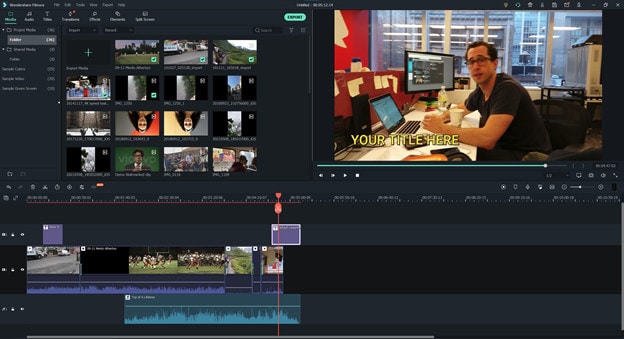
Key features
- Preset Templates
- Instant Mode
- Motion Tracking
- AI Editing Effects
- Auto Synchronization
- Plug-ins
Price
- Annual Plan: $49.99
- Perpetual Plan: $79.99
Pros
- Seamless interface for beginners
- Great customer support
- Plenty of effects and preset templates
- 4K video output options
Cons
- Rendering requires too much time
- The mobile app requires separate subscription
Supported OS: Windows , Mac , iOS , Android , iPad
G2 Ratings: 4.4 stars out of 5
Summary
Filmora’s intuitive interface allows experienced and brand-new users to create incredible videos with flawless special effects. Its high ratings and multiple supported formats make it quite popular among users.
2. Avidemux Video Editor
If you are a beginner and want to use a free, open-source software program for basic video editing, then Avidemux is a good choice. The interface is not as fancy as it could be, but there are some presets that’ll save you a lot of time. Avidemux is a cross-platform video editor that allows you to create custom videos, but it doesn’t feature the ability to share the edited footage to social media directly,
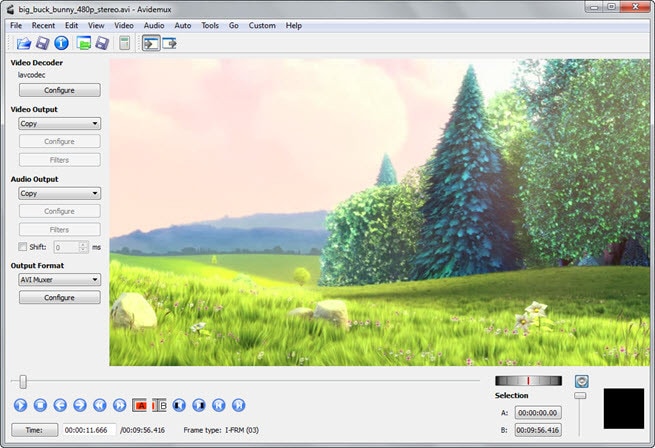
Key features
- Video and Audio Filters
- Support Popular Formats
- Convert Video For Archiving or Publishing
Price: Free
Pros
- It can convert Video To A Smaller Size
- Easy cut, trim, split video
Cons
- Out-dated UI
- Lacks sharing option
Supported OS: Windows , OS X , Linux , BSD
Uptodown Ratings: 4.0 stars out of 5
Summary
An open-source video editor that supports most formats. Due to its obsolete UI and lack of sharing features, Avidemux has average ratings.
3. VirtualDub
This open-source software is user-friendly and allows users with little experience to navigate the software without much trouble. It supports 3rd party apps and also offers batch-processing, which means working on multiple videos simultaneously makes it possible.
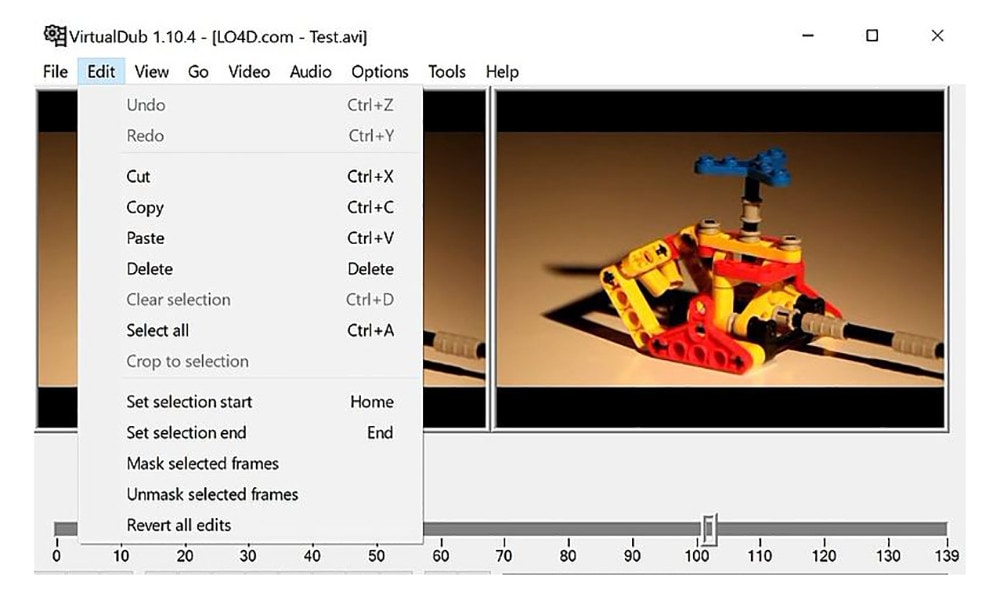
Key features
- Integrated volume and histogram meter
- Optimized disk
- Noise reduction
- Fractional frame rates
Price: Free
Pros
- Clean interface, easy to use
- Keyboard and mouse shortcuts for faster operation
- Free to use
Cons
- Not suitable for 4K editing
- Lack learning material
- Obsolete Interface
Supported OS: Windows
Compare Camp Ratings: 4.0 stars out of 5
Summary
Virtual Dub supports multitasking, and its features are pretty helpful. However, it lacks 4k editing and a friendly interface. Overall Virtual Dub is a good choice.
4. Sony Vegas Movie Studio
This video editing software makes it easy to create professional-looking videos in minimum time and effort. Vegas Movie Studio software is best for video editing professionals who have been doing it for some time and are looking for something a little more sophisticated than free alternatives. Not only does it has a high retail price, but its internal elements can be too complex for those just beginning.
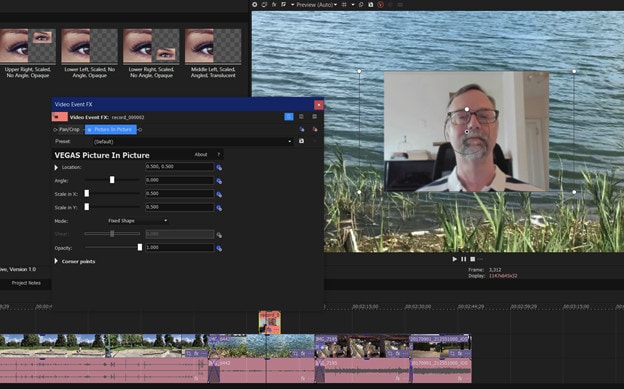
Key features
- Color correction
- HDV and AVCHD-editing
- DV batch capture
- Wide variety of file formats and codecs
Price: Starting from $7.99 USD per month
Pros
- Customizable interface
- Multicam editing
- Lots of effects and transitions, with plug-in capability
- Good slow motion and warp flow transition tools
Cons
- Less intuitive interface than competitors
- Import from camcorder not ideal
- Some tools are complex
Supported OS: Windows
G2 Ratings: 4.4 out of 5
Summary
Vegas Movie Studio is the choice of professionals. It does all the work without taking up a lot of resources, and like most programs, there is a learning curve. It’s not always intuitive for beginners, but its professional and powerful features score decent in most reviews.
5. WeVideo
This cloud-based application is a simple-to-use video editing and sharing suite. WeVideo is a full-featured video editing application that uses JumpStart technology to create amazing videos. It’s an innovative app that offers a seamless editing experience as it supports multiple formats of video, images, audio, and graphics.
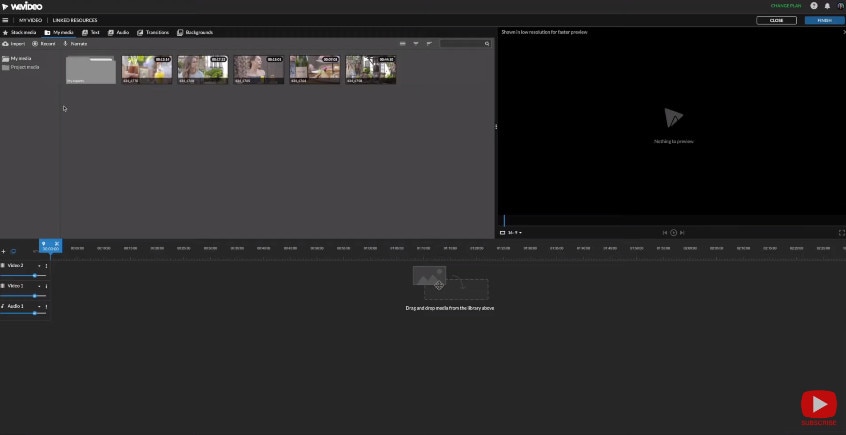
Key features
- WeVideo JumpStart
- Cloud storage
- Built-in graphics
- Customizable environment
- Advanced text editing
- Multi-track editing and storyboard
Price
- Free trial
- Power Plan: $9.99/month
- Unlimited Plan: $15.99/month
- Professional Plan: $39.99/month
- Business Plan: $73.99/month
Pros
- Constantly improving features
- Ease of use
- Storage is cloud-based
Cons
- Old fashion transition
- Leaves a watermark on free trial
Supported OS: Online
Trustpilot Ratings: 4 stars out of 5
Summary
WeVideo is a straightforward yet robust video editor. It offers a variety of features and supports multiple formats, plus its comprehensive pricing plan makes it useful for everyone.
6. Lightworks
Lightworks is the most powerful video editor in its class and an excellent tool for professionals who want to make amazing videos quickly. Lightworks is very fast and straightforward to use, and it has some great features you won’t find in any other video editor. It is available on all popular OS.
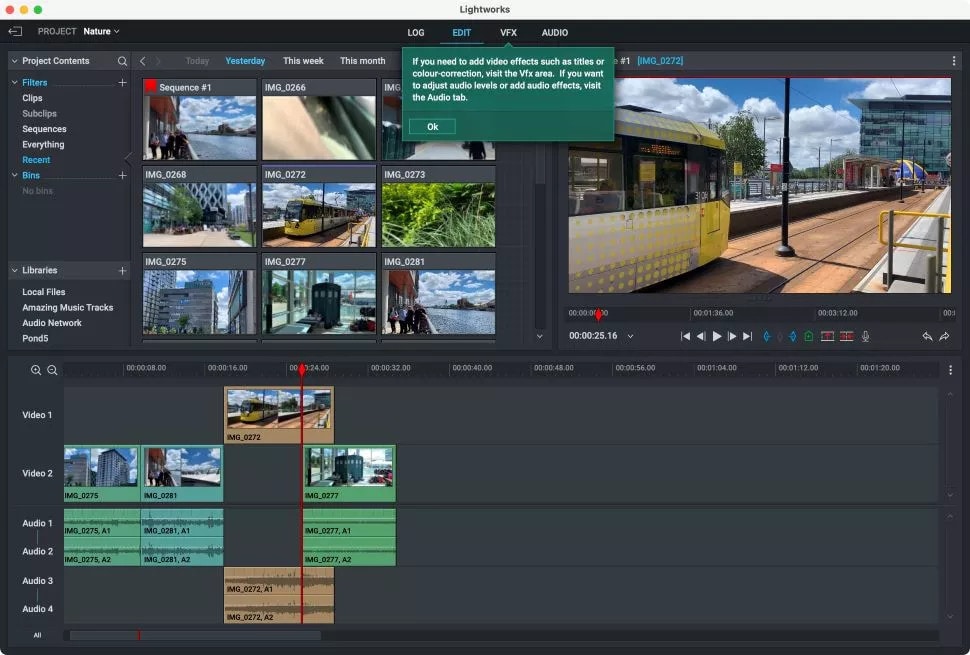
Key features
- Audio and Video Effect Plugin Support
- Cloud Connected
- Motion Graphics
- Advanced Metadata
- Proxy Workflows
- Apple ProRes decoding
Price
- Monthly Plan: $9.99/user
- Yearly Plan: $9.99/user
- Perpetual: $154.99
Pros
- High-resolution timeline rendering
- It has social media export templates
- Interfaces for multiple OS are consistent
- Instant autosave
Cons
- Commands are not always intuitive
- A bit pricey as compared to its competitors
Supported OS: Windows , Mac , Linux
Techradar Pro Ratings: 4 stars out of 5
Summary
Lightworks is not any other video editing tool available on the market of video editing tools. This video editing tool provides amateurs with the most sophisticated features in an optimized platform. Its scores are the highest on almost every review site.
7. ShotCut
Shotcut is a multiplatform video editor that lets you work with various formats for audio, video, image files, etc. This video editor makes it easy to mix and match the resolution and frame rates in a video file. All the changes you make in the editor can be undone and redone often. Shotcut is the best choice for video editing, without question.

Key features
- Webcam capture
- Audio scopes and filters
- Deinterlacing
- Eyedropper tool
- Video wipe transitions
- Keyframes for filter parameters
Price: Free
Pros
- Support for 4K resolutions
- Free
Cons
- Less intuitive than commercial apps
- Lacks built-in sharing to popular sites
Supported OS: Windows , Mac , Linux
GetApp Ratings: 4.5 out of 5 stars
Summary
Shotcut is an open-source video editor for creative professionals and is available on mac, Windows, and Linux. The free version of Shotcut has many excellent features, but it doesn’t have the slick interface or advanced techniques of the top paid editors.
8. OpenShot
An award-winning open-source video editor that creates stunning videos. OpenShot is a fast, easy-to-use, and surprisingly powerful video editor. OpenShot Video Editor allows you to work with many different types of tracks so that your edits will seem natural. OpenShot Video Editor allows you to add your custom animations or titles. The options are endless, so it all depends on your time and interest. It is available in more than 70 languages, making it ideal for all types of users.
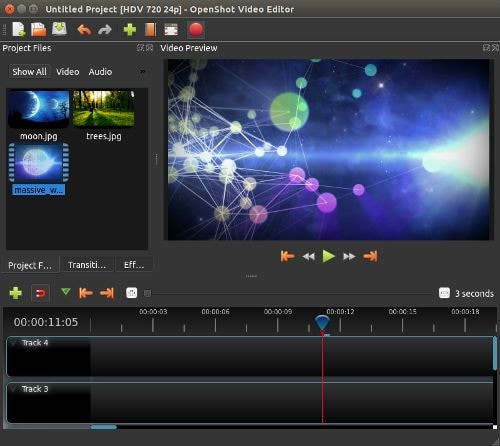
Key features
- 3D animations
- Animation and keyframes
- Multiple languages and formats
- Cross-platform
- Video-effects
Price: Free
Pros
- It is a non-linear editor with infinite tracks
- 100% free without watermark
- Frequent updates
Cons
- Obsolete interface
- Unstable performance
- Lacks some editing features
Supported OS: Window , Mac , Linux , Chrome OS
Getapp Ratings: 4.2 stars out of 5
Summary
Another open-source video-editor in the list is named OpenShot. It’s a multi-lingual and multi-supported app with unique features. Despite its unstable performance, OpenShot is still an ideal choice for many users.
9. Movavi Video Editor Plus
Movavi Video Editor Plus is the perfect tool to bring your creative ideas to life. It has special effects, ready-made intros, and keyframe animation. Using chroma keying, you can change the background of your video clips to any color or pattern that suits your need. Movavi has now redesigned its user interface to make it easy to use.
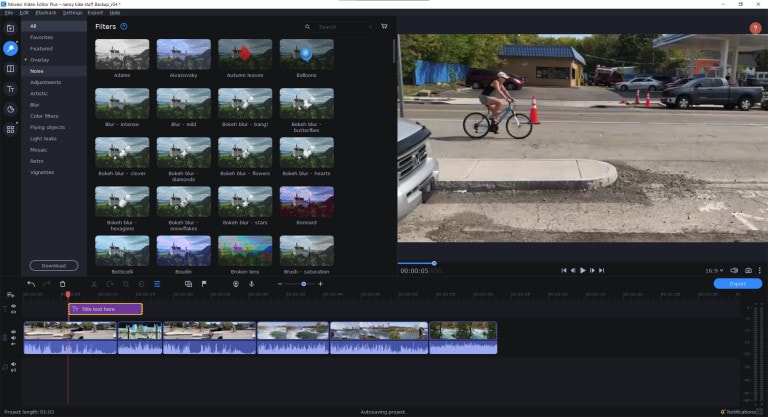
Key features
- Effects and transitions
- Built-in media pack
- Fast processing of 4K videos
- Keyframe animation
- Automatic video creation
- Cutting, trimming, joining
Price
- Free version: 7 days
- Video Editor Plus 1 year /1 PC: $49.95
- Video Editor Plus Lifetime /1 PC: $69.95
- Video Suite Lifetime /1 PC: $89.95
Pros
- Easy-to-understand user interface
- Transitions with sound
- Motion tracking and picture-in-picture tools
- Chroma-key capability
- Quick movie-creation tool
Cons
- Lacks advanced trim modes
- Slow rendering
PCMag Ratings: 4.0 stars out of 5
Summary
If you want to edit your videos with a minimal learning curve, try Movavi. You get PiP, chroma-keying, titling, basic keying, and motion tracking. The program is simple to use but doesn’t have all the features and stands four stars.
10. VSDC Free Video Editor
VSDC Free Video Editor is an online tool that lets you edit audio and video files to make your creations like movies, YouTube tutorial videos, and more. The audio and video files supported are extensive, and the software includes a codec manager. The Pro version isn’t necessary if you’re using the free edition of the software; it’s more than enough to get the job done.
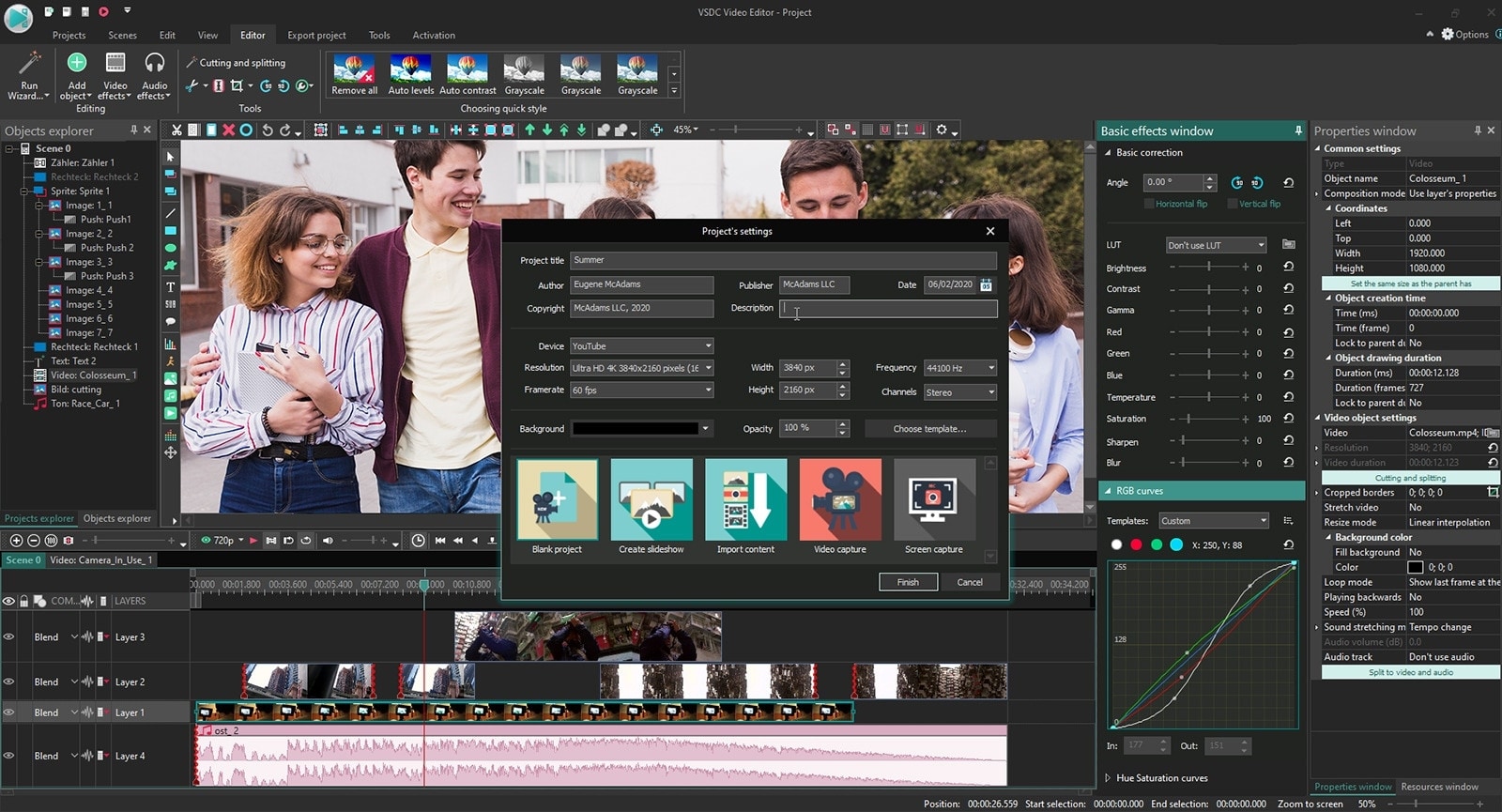
Key features
- Dark theme
- Subpixel Accuracy
- Powerful Chroma Key tool
- Trendy video effects, filters, and transitions
- Color Blending And Filters
- Built-In DVD Burning Tool
Price: Free
Pros
- Non-linear
- Video effects library
- Video stabilization
- Masking
Cons
- Outdated interface
- Lack keyboard shortcuts
- Only available on Windows
Supported OS: Windows
Capterra Ratings: 4.5 stars out 5
Summary
VSDC is a non-linear editor with extensive format support. It includes all the essential features an editor requires but with an obsolete UI. It is also ideal for many who need a powerful yet free video editor.
11. VideoPad Video Editor
VideoPad is a free video editor that can create stunning videos and perform basic editing tasks. A good video editor can help you to create videos for different social media platforms. You can make your videos look professional and polished with a few clicks and some simple editing skills. There’s nothing particularly exciting or advanced about this app; it’s simple enough for anyone new to video editing or even for seasoned editors. But the simple and easy-to-use interface makes the entire process very exciting.
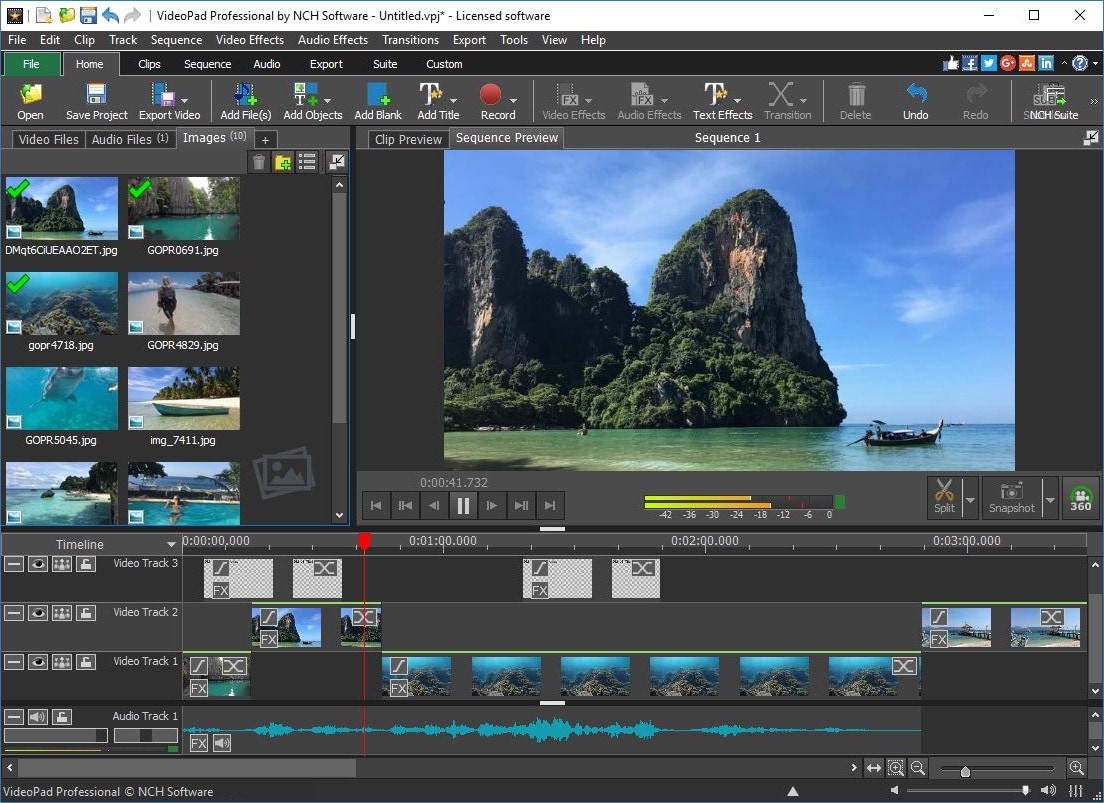
Key features
- Text snippets
- Range of transitional effects
- Plug-ins Library
- Burn finished videos to Blu-Ray, DVD, etc.
- Color correction and light balance.
Price: Free
Pros
- Simple and clean interface
- Supports multiple file formats
- Includes video effects
- Lightweight on system resources
Cons
- Lack of advanced features
Supported OS: Windows , Mac , iPad/iPhone
Tom’s guide Ratings: 3.5 stars out of 5
Summary
Video pad is a free video editor designed for beginners that is lightweight and simple. VideoPad is also great for creating quick videos for social media purposes like Youtube and Facebook. The software has a high rating, as shown above, and it’s available on Windows.
12. HitFilm
HitFilm is a helpful video editing software that makes editing easier for users. In addition to basic features, the program also provides advanced-level functions that make edited videos pop. Hitfilm Express Download has more than 400 features to help casual video editors save time. Features like: visual effects, cinematic elements, and compositing tools preset help unleash your creativity.
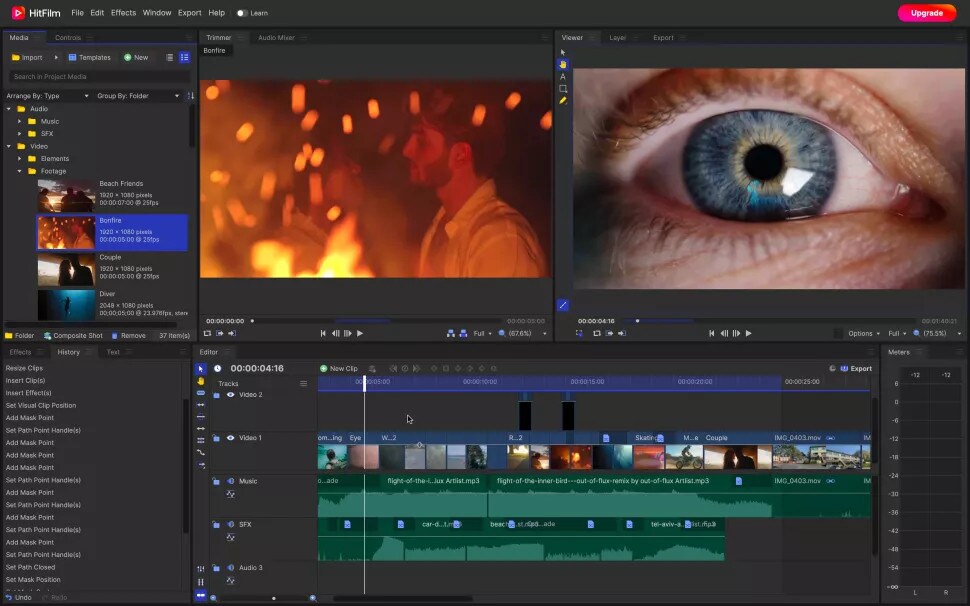
Key features
- Color Grading and correction
- Smart search
- Commentator recorder
- Lightning and lens flares
- 3D camera tracker
Price
- Free trial
- Creator: $7.50
- Pro: $12.50
- Enterprise: Custom pricing
Pros
- Intuitive interface
- It offers free tutorials and masterclasses
- Works on both Windows and Mac
Cons
- It requires heavy system requirements
TechRadar Ratings: 4.5 stars out of 5
Summary
HitFilm Express 15 is a powerful free video editing program that enables you to create high-quality videos in minutes with an intuitive interface. It offers advanced editing features such as advanced video trimming, 3D editing, and more.
13. Magix Movie Studio
Magix is the world’s leading professional audiovisual media software, with Sequoia being its industry-standard audio editing software. This movie editor is an enthusiast-level video editing software that competes with software from Adobe and CyberLink, and it even boasts support for 4K content and 360 degrees. There are many reasons to upgrade. This year’s update includes stabilization, 8K editing, motion tracking, and an in-app plug-in store.
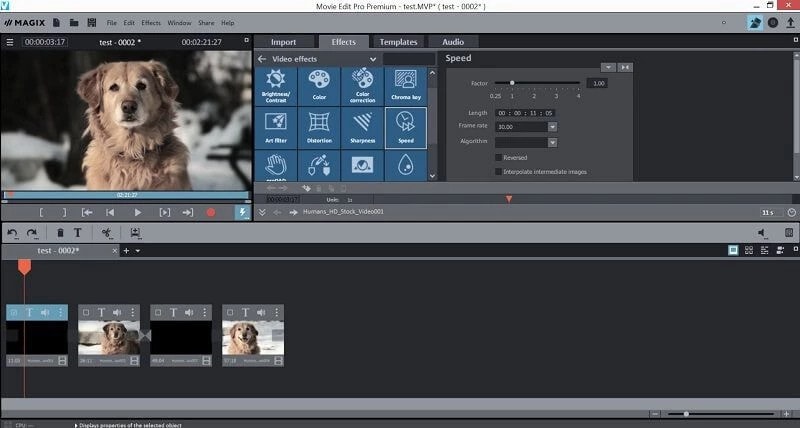
Key features
- NewBlue effects
- Fly-in animation
- New filter view
- Stabilization
- Motion tracking
- 8k support
Price
- Movie Studio 2024: $69.99 (30-day free trial)
- Movie Studio 2024 Platinum: $99.99 (30-day free trial)
- Movie Studio 2024 Suite: $129.00 (30-day free trial)
Pros
- Lots of video effects
- Responsive editing interface
- Multicam
- Trailer-like movie templates
- Solid audio editing
Cons
- Slower project rendering than others
- Lacks import and organization tools
Supported OS: Windows
PCMag Ratings: 3 stars out of 5
Summary
Magix movie studio is a powerful all-around video editing tool with many features that professional users have come to expect. It’s also relatively simple to use. But usability and performance are poor compared to other software programs like Filmora .
Part 4: How To Edit a Video With a Windows Movie Maker Alternative
Windows Movie Maker was great for editing a video, but it’s no match for some of the best video editing software. We’re talking about software capable of creating a cinematic experience in seconds, all on your computer.
When you need to edit a video with simple, quick edits, like adding a special effect or changing the background, try Filmora . Filmora is an easy-to-use application that allows you to create a movie using simple tools that don’t require additional training. You can’t beat this option if you want to create a professional-quality video for your blog or website.
Let’s dive into a quick tutorial on editing videos in Filmora:
Free Download For Win 7 or later(64-bit)
Free Download For macOS 10.14 or later
Step1 Open Wondershare Filmora on your PC or Mac
You can start a new project by clicking on ‘New Project’. And you can also change the ‘Aspect Ratio’ according to your project demand.

Step2 Import Videos
You can import your file by clicking the import tab on the upper-left side or clicking the import icon on the main window.
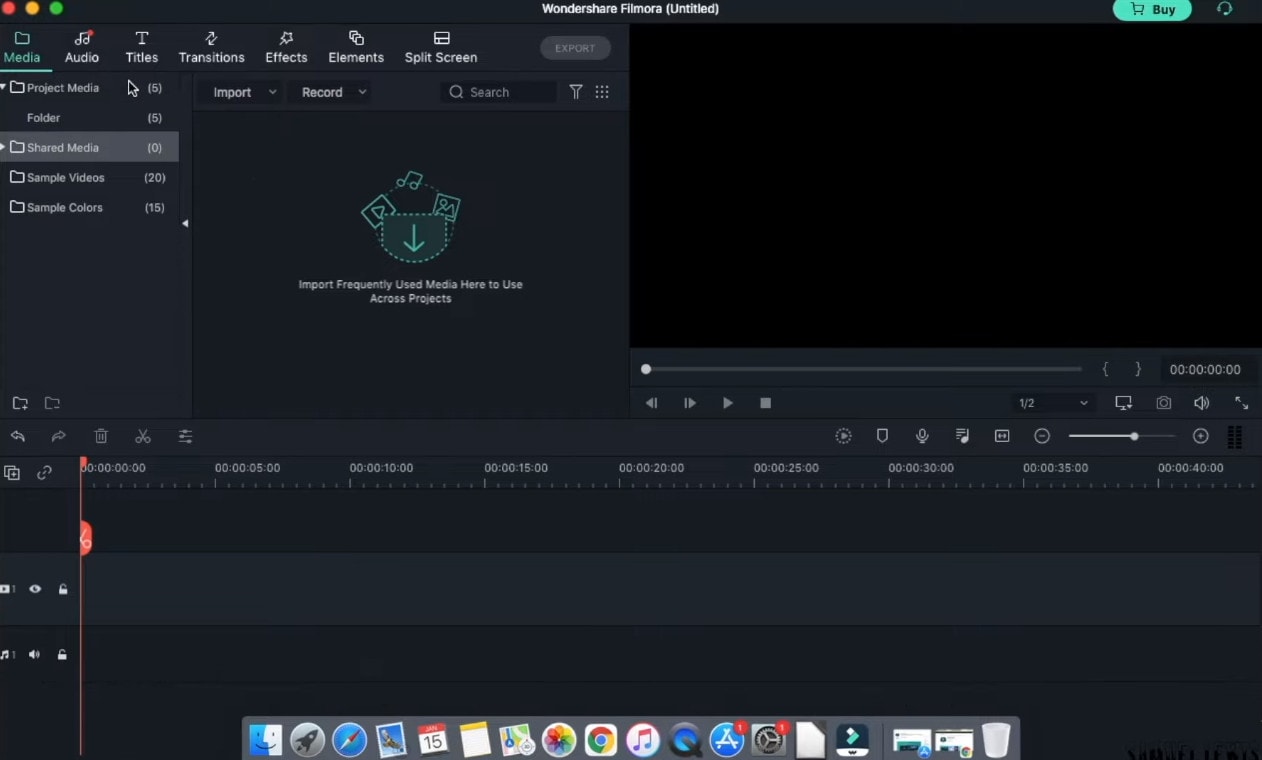
Step3 Drag and drop your footage to the timeline
After importing all the files, click and hold each individual video and drag and drop it to the timeline area according to your ideal sequence.
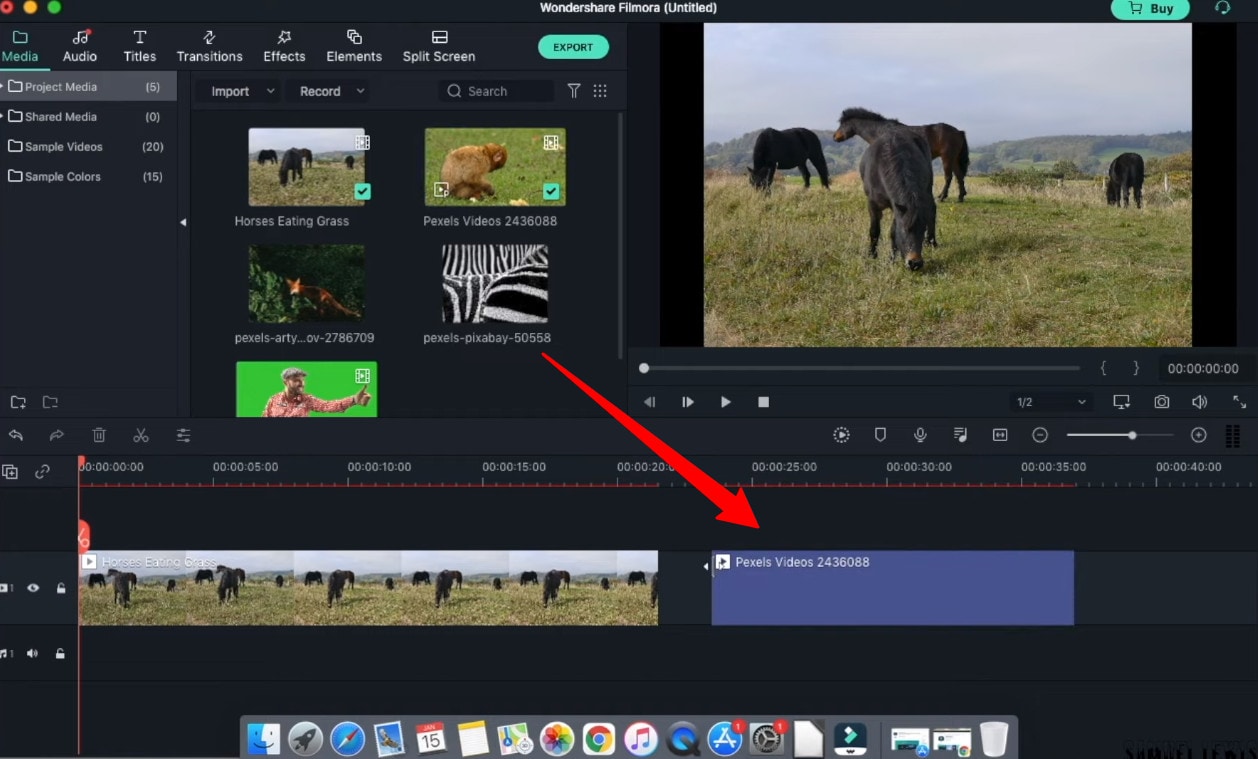
Step4 Add Audio
Go to the ‘Audio’ tab and select the audio file from the audio library. Once selected, drag and drop the audio file into the music timeline.
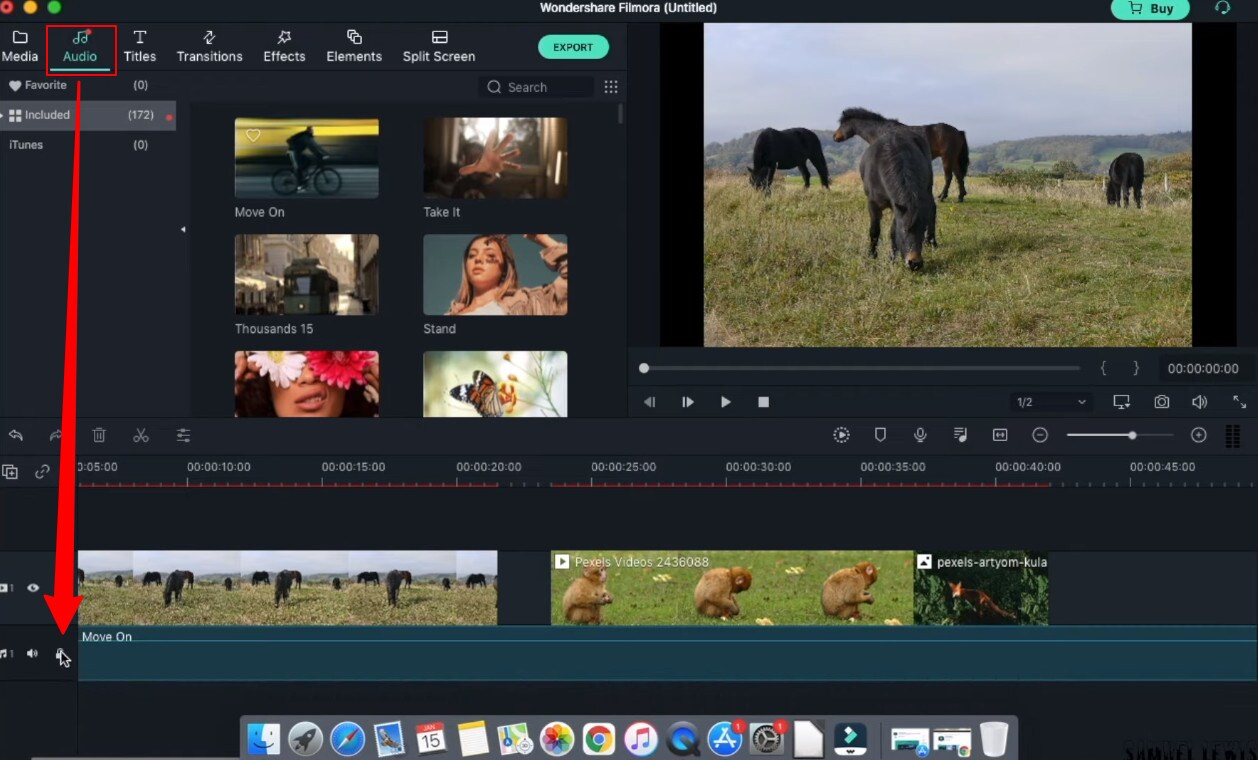
Step5 Add Titles
In your video intro, you can insert some title text. Go to the ‘Titles’ tab and select the one you like, and drag and drop it on top of the timeline. Double-click and edit the text and state your ideal statements. You can customize your text fonts and color too.
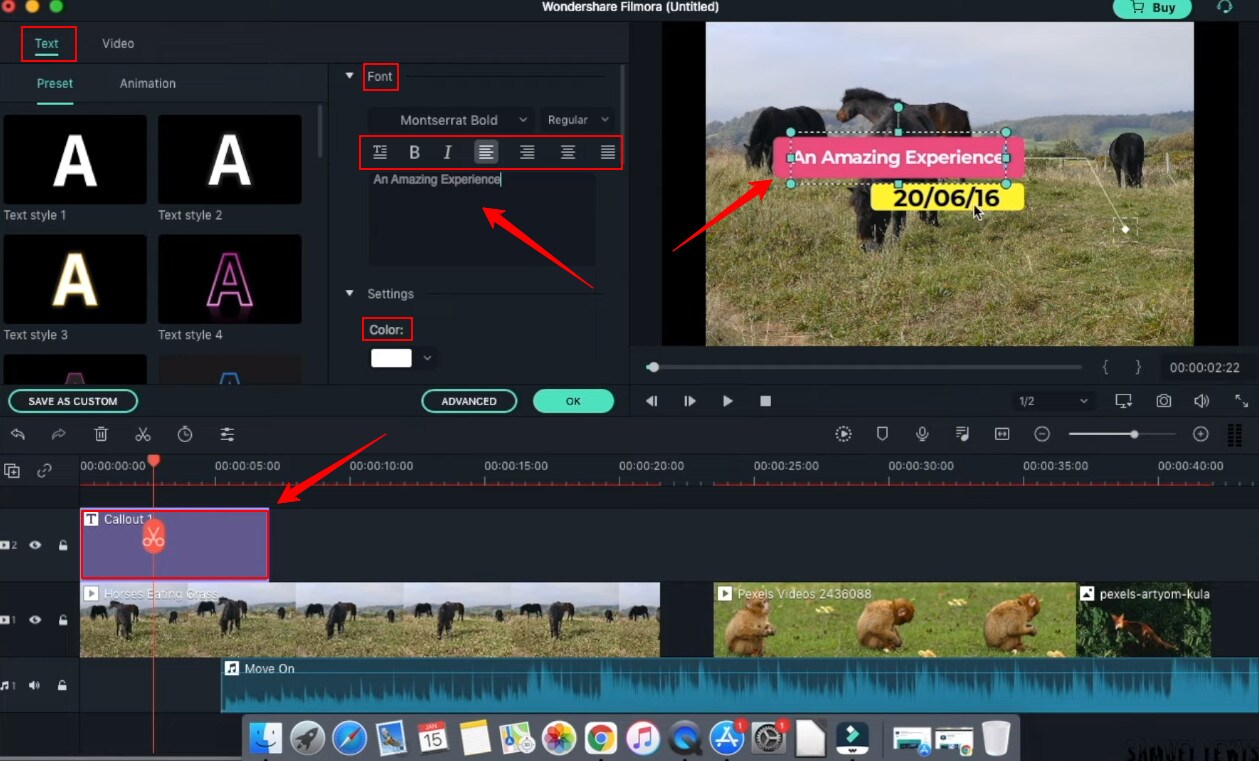
Step6 Add Transitions
You can add transition effects to ensure a smooth transition from one scene to another. The overall will get more professional look.

Step7 Add Effects
Next; you can get special effects to your video to make them more attractive and engaging to watch. Simple drag down the effect to your video and watch the effect take place in your selective scene.
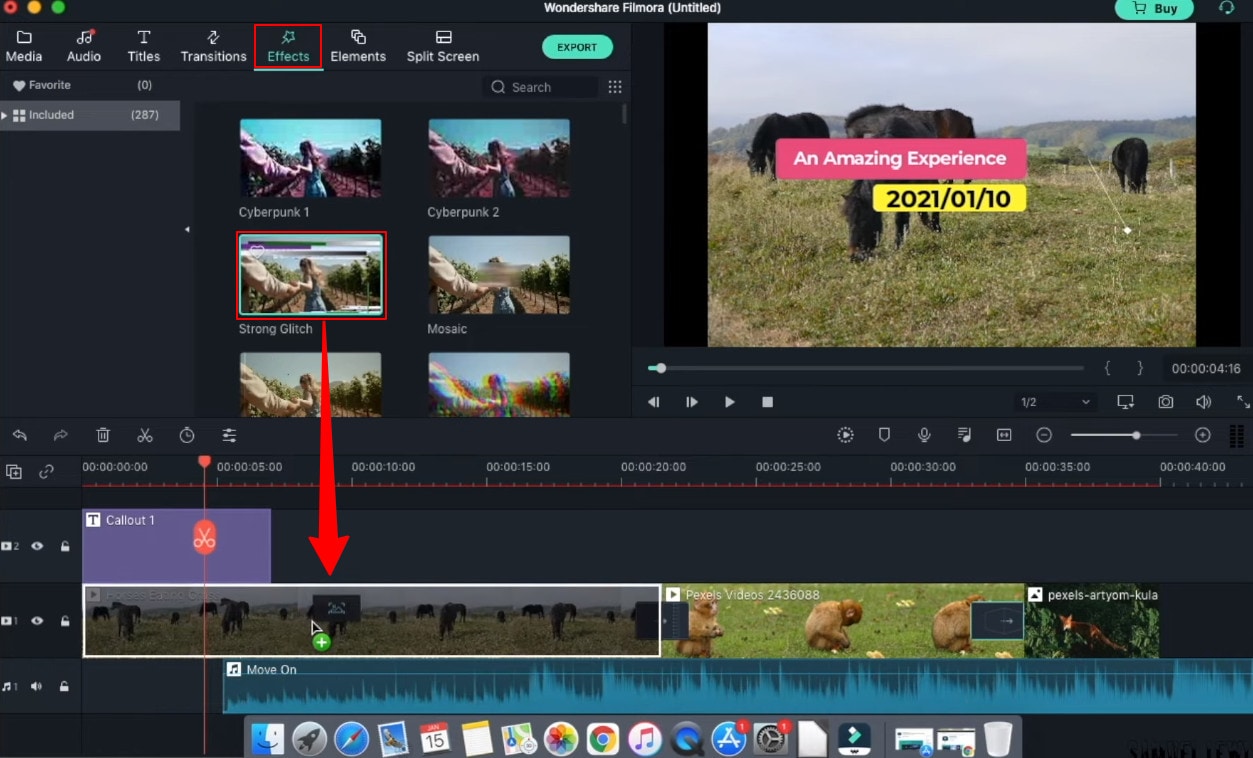
Step8 Export your work
Once all the changes have been made, hit ‘export’ from the top tab. A window will appear where you can change the settings, resolution, frame rate, bit rate, etc. Next, click the ‘export’ button down on that window, and then you can save the file in your drive.
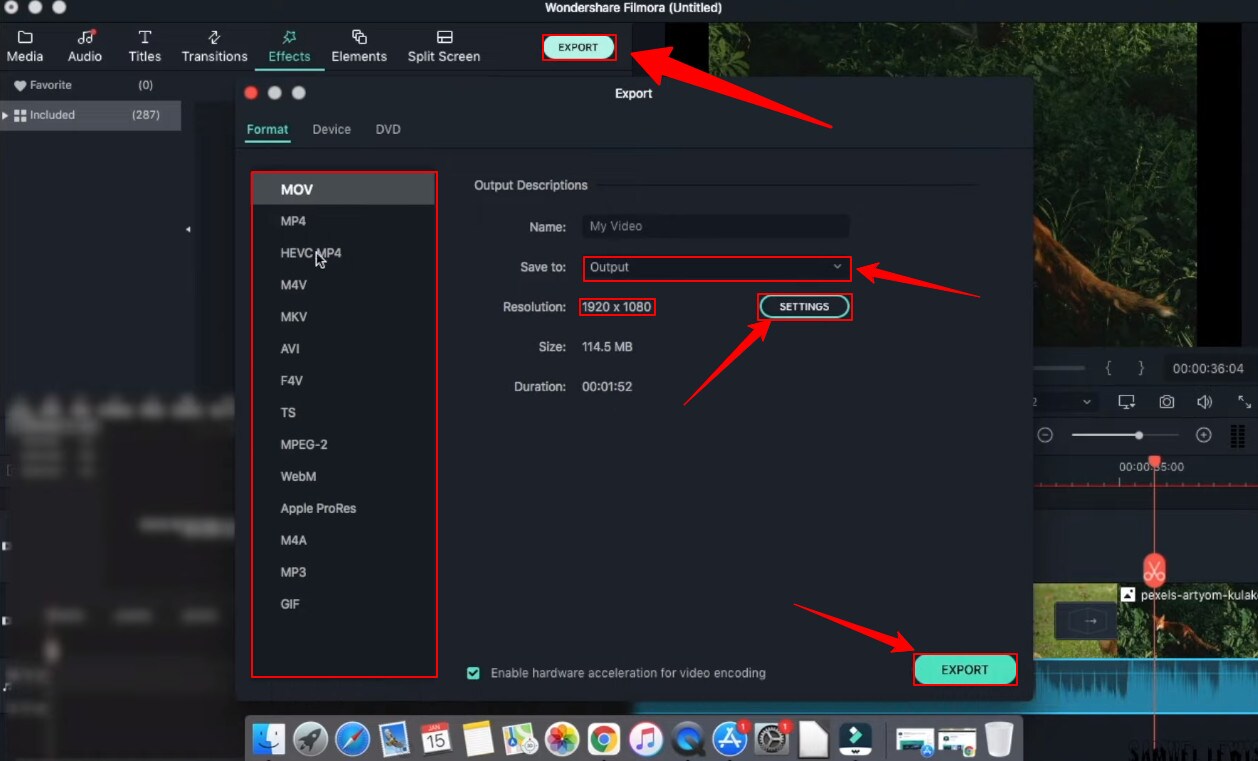
Part 5: Hot FAQs on Windows Movie Maker Alternatives
1. Why is Windows Movie Maker discontinued?
Microsoft’s video editing program, Windows Movie Maker, did not become a big hit with the public because it failed to do well on the market. Microsoft couldn’t get the support they were looking for from the program’s users. As a result, Microsoft had to cease its support of the program.
2. Is there a free version of Windows Movie Maker?
Microsoft Windows Movie maker was always accessible and pre-installed every windows product. Microsoft has discontinued support for Movie Maker and warns about free downloads of Movie Maker provided by third parties that might contain malware, viruses, or other issues.
3. What are the best free Windows Movie Maker Alternatives for Mac?
After switching to a Mac, you’ll find that the Windows Movie Maker alternatives offer much more than just a simple video editor. They provide advanced features, easy transitions, and less technical know-how to create pro-quality results. You should try using these platforms on your Mac if you have a video to edit.
- Wondershare Filmora
- Movavi
- OpenShot
Final Words
Windows Movie Maker is an excellent Windows video editor application for Windows users. But in recent years, it has become outdated due to the continuous development of new technologies. There are many alternatives for Windows Movie Maker, and here we listed some of the best ones. Most of them are free and featured packs. Each program has its unique set of features and capabilities, and each one excels in different areas. Check them out and see what you think.
Free Download For Win 7 or later(64-bit)
Free Download For macOS 10.14 or later
Part 1: Top 3 Picks for Windows Movie Maker Alternatives
The world’s best video editing software is about to change. We look at three of the most popular and valuable alternatives to Windows Movie Maker.
You will need to consider these alternatives to ensure they meet your expectations and needs.
1. Wondershare Filmora - Best Overall

Filmora is the best Windows Movie Maker Alternative designed according to your convenience.
Ratings: 4.4 Stars out 5
Starting from $49.99
2. Magix Movie Studio - Best for Collages

This alternative offers a variety of tools and plugins for anyone who wants to create professional-level videos in under a minute.
Download on Windows
Ratings: 4 stars out of 5
30-day free trials, then starts from $69.99 all the way to $129
3. Avidemux Video Editor - Best Open-Source Editor

An open-source editor that supports a wide range of formats is free! Avidemux has an interface similar to Windows Movie Maker, which makes it a perfect alternative.
Download on Windows
Ratings: 4.0 stars out of 5
Free Trial
Part 2: Ultimate Overview on 13 Best Alternatives to Windows Movie Maker
We live in visual culture, and we constantly see, capture, upload, and share videos on our smartphones, tablets, and laptops. So, it is only natural that more people seek ways to edit their videos. Windows Movie Maker was one of the most popular video editing apps. So it’s time to dig into the best Windows Movie Maker alternatives, which are arguably better and feature-rich.
| Software | OS | Media Resources | AI editing | Easy to Use | Free Trial |
|---|---|---|---|---|---|
| Wondershare Filmora | WindowsMacMobile | Yes | Yes | Yes | Yes |
| Avidemux | WindowsOS XLinuxBSD | Yes | No | Yes | Yes |
| Virtual Dub | Windows | No | No | Yes | Yes |
| Vegas Movie Studio | Windows | Yes | Yes | No | No |
| WeVideo | Online | Yes | No | Yes | Yes |
| Lightworks | LinuxOS X Windows | Yes | Yes | No | No |
| ShotCut | WindowsMacLinuxBSD | Yes | No | No | Yes |
| OpenShot | WindowsMacLinuxChrome OS | Yes | No | Yes | Yes |
| Movavi Plus | WindowsMac | Yes | No | Yes | Yes |
| VSDC | Windows | Yes | No | Yes | Yes |
| VideoPad | WindowsMaciPad/iPhone | Yes | No | Yes | Yes |
| HitFilm | WindowsMac | Yes | Yes | Yes | Yes |
| Magix Movie Studio | Windows | Yes | Yes | No | Yes |
Part 3: 13 Best Windows Movie Maker Alternatives for Windows
As we all know, Windows Movie Maker is the most used and trusted tool for creating videos in Windows. With its unique features and user-friendly interface, people often use this software to develop short and entertaining videos.
However, the fact is that Windows Movie Maker is not the current best video editing software for creating complex video projects. For this reason, we compiled a list of the 12 best alternatives to offer you a better option for Windows Movie Maker.
1. Wondershare Filmora
Filmora 11 is a powerful, easy-to-use video editor specially designed to streamline your workflow and save you hours weekly. It supports everything from Windows, Mac, and IOS to Android. The latest update to the flagship app includes several key enhancements that result in a much more efficient video creation workflow and one that’s easier to use than its rivals.

Key features
- Preset Templates
- Instant Mode
- Motion Tracking
- AI Editing Effects
- Auto Synchronization
- Plug-ins
Price
- Annual Plan: $49.99
- Perpetual Plan: $79.99
Pros
- Seamless interface for beginners
- Great customer support
- Plenty of effects and preset templates
- 4K video output options
Cons
- Rendering requires too much time
- The mobile app requires separate subscription
Supported OS: Windows , Mac , iOS , Android , iPad
G2 Ratings: 4.4 stars out of 5
Summary
Filmora’s intuitive interface allows experienced and brand-new users to create incredible videos with flawless special effects. Its high ratings and multiple supported formats make it quite popular among users.
2. Avidemux Video Editor
If you are a beginner and want to use a free, open-source software program for basic video editing, then Avidemux is a good choice. The interface is not as fancy as it could be, but there are some presets that’ll save you a lot of time. Avidemux is a cross-platform video editor that allows you to create custom videos, but it doesn’t feature the ability to share the edited footage to social media directly,

Key features
- Video and Audio Filters
- Support Popular Formats
- Convert Video For Archiving or Publishing
Price: Free
Pros
- It can convert Video To A Smaller Size
- Easy cut, trim, split video
Cons
- Out-dated UI
- Lacks sharing option
Supported OS: Windows , OS X , Linux , BSD
Uptodown Ratings: 4.0 stars out of 5
Summary
An open-source video editor that supports most formats. Due to its obsolete UI and lack of sharing features, Avidemux has average ratings.
3. VirtualDub
This open-source software is user-friendly and allows users with little experience to navigate the software without much trouble. It supports 3rd party apps and also offers batch-processing, which means working on multiple videos simultaneously makes it possible.

Key features
- Integrated volume and histogram meter
- Optimized disk
- Noise reduction
- Fractional frame rates
Price: Free
Pros
- Clean interface, easy to use
- Keyboard and mouse shortcuts for faster operation
- Free to use
Cons
- Not suitable for 4K editing
- Lack learning material
- Obsolete Interface
Supported OS: Windows
Compare Camp Ratings: 4.0 stars out of 5
Summary
Virtual Dub supports multitasking, and its features are pretty helpful. However, it lacks 4k editing and a friendly interface. Overall Virtual Dub is a good choice.
4. Sony Vegas Movie Studio
This video editing software makes it easy to create professional-looking videos in minimum time and effort. Vegas Movie Studio software is best for video editing professionals who have been doing it for some time and are looking for something a little more sophisticated than free alternatives. Not only does it has a high retail price, but its internal elements can be too complex for those just beginning.

Key features
- Color correction
- HDV and AVCHD-editing
- DV batch capture
- Wide variety of file formats and codecs
Price: Starting from $7.99 USD per month
Pros
- Customizable interface
- Multicam editing
- Lots of effects and transitions, with plug-in capability
- Good slow motion and warp flow transition tools
Cons
- Less intuitive interface than competitors
- Import from camcorder not ideal
- Some tools are complex
Supported OS: Windows
G2 Ratings: 4.4 out of 5
Summary
Vegas Movie Studio is the choice of professionals. It does all the work without taking up a lot of resources, and like most programs, there is a learning curve. It’s not always intuitive for beginners, but its professional and powerful features score decent in most reviews.
5. WeVideo
This cloud-based application is a simple-to-use video editing and sharing suite. WeVideo is a full-featured video editing application that uses JumpStart technology to create amazing videos. It’s an innovative app that offers a seamless editing experience as it supports multiple formats of video, images, audio, and graphics.

Key features
- WeVideo JumpStart
- Cloud storage
- Built-in graphics
- Customizable environment
- Advanced text editing
- Multi-track editing and storyboard
Price
- Free trial
- Power Plan: $9.99/month
- Unlimited Plan: $15.99/month
- Professional Plan: $39.99/month
- Business Plan: $73.99/month
Pros
- Constantly improving features
- Ease of use
- Storage is cloud-based
Cons
- Old fashion transition
- Leaves a watermark on free trial
Supported OS: Online
Trustpilot Ratings: 4 stars out of 5
Summary
WeVideo is a straightforward yet robust video editor. It offers a variety of features and supports multiple formats, plus its comprehensive pricing plan makes it useful for everyone.
6. Lightworks
Lightworks is the most powerful video editor in its class and an excellent tool for professionals who want to make amazing videos quickly. Lightworks is very fast and straightforward to use, and it has some great features you won’t find in any other video editor. It is available on all popular OS.

Key features
- Audio and Video Effect Plugin Support
- Cloud Connected
- Motion Graphics
- Advanced Metadata
- Proxy Workflows
- Apple ProRes decoding
Price
- Monthly Plan: $9.99/user
- Yearly Plan: $9.99/user
- Perpetual: $154.99
Pros
- High-resolution timeline rendering
- It has social media export templates
- Interfaces for multiple OS are consistent
- Instant autosave
Cons
- Commands are not always intuitive
- A bit pricey as compared to its competitors
Supported OS: Windows , Mac , Linux
Techradar Pro Ratings: 4 stars out of 5
Summary
Lightworks is not any other video editing tool available on the market of video editing tools. This video editing tool provides amateurs with the most sophisticated features in an optimized platform. Its scores are the highest on almost every review site.
7. ShotCut
Shotcut is a multiplatform video editor that lets you work with various formats for audio, video, image files, etc. This video editor makes it easy to mix and match the resolution and frame rates in a video file. All the changes you make in the editor can be undone and redone often. Shotcut is the best choice for video editing, without question.

Key features
- Webcam capture
- Audio scopes and filters
- Deinterlacing
- Eyedropper tool
- Video wipe transitions
- Keyframes for filter parameters
Price: Free
Pros
- Support for 4K resolutions
- Free
Cons
- Less intuitive than commercial apps
- Lacks built-in sharing to popular sites
Supported OS: Windows , Mac , Linux
GetApp Ratings: 4.5 out of 5 stars
Summary
Shotcut is an open-source video editor for creative professionals and is available on mac, Windows, and Linux. The free version of Shotcut has many excellent features, but it doesn’t have the slick interface or advanced techniques of the top paid editors.
8. OpenShot
An award-winning open-source video editor that creates stunning videos. OpenShot is a fast, easy-to-use, and surprisingly powerful video editor. OpenShot Video Editor allows you to work with many different types of tracks so that your edits will seem natural. OpenShot Video Editor allows you to add your custom animations or titles. The options are endless, so it all depends on your time and interest. It is available in more than 70 languages, making it ideal for all types of users.

Key features
- 3D animations
- Animation and keyframes
- Multiple languages and formats
- Cross-platform
- Video-effects
Price: Free
Pros
- It is a non-linear editor with infinite tracks
- 100% free without watermark
- Frequent updates
Cons
- Obsolete interface
- Unstable performance
- Lacks some editing features
Supported OS: Window , Mac , Linux , Chrome OS
Getapp Ratings: 4.2 stars out of 5
Summary
Another open-source video-editor in the list is named OpenShot. It’s a multi-lingual and multi-supported app with unique features. Despite its unstable performance, OpenShot is still an ideal choice for many users.
9. Movavi Video Editor Plus
Movavi Video Editor Plus is the perfect tool to bring your creative ideas to life. It has special effects, ready-made intros, and keyframe animation. Using chroma keying, you can change the background of your video clips to any color or pattern that suits your need. Movavi has now redesigned its user interface to make it easy to use.

Key features
- Effects and transitions
- Built-in media pack
- Fast processing of 4K videos
- Keyframe animation
- Automatic video creation
- Cutting, trimming, joining
Price
- Free version: 7 days
- Video Editor Plus 1 year /1 PC: $49.95
- Video Editor Plus Lifetime /1 PC: $69.95
- Video Suite Lifetime /1 PC: $89.95
Pros
- Easy-to-understand user interface
- Transitions with sound
- Motion tracking and picture-in-picture tools
- Chroma-key capability
- Quick movie-creation tool
Cons
- Lacks advanced trim modes
- Slow rendering
PCMag Ratings: 4.0 stars out of 5
Summary
If you want to edit your videos with a minimal learning curve, try Movavi. You get PiP, chroma-keying, titling, basic keying, and motion tracking. The program is simple to use but doesn’t have all the features and stands four stars.
10. VSDC Free Video Editor
VSDC Free Video Editor is an online tool that lets you edit audio and video files to make your creations like movies, YouTube tutorial videos, and more. The audio and video files supported are extensive, and the software includes a codec manager. The Pro version isn’t necessary if you’re using the free edition of the software; it’s more than enough to get the job done.

Key features
- Dark theme
- Subpixel Accuracy
- Powerful Chroma Key tool
- Trendy video effects, filters, and transitions
- Color Blending And Filters
- Built-In DVD Burning Tool
Price: Free
Pros
- Non-linear
- Video effects library
- Video stabilization
- Masking
Cons
- Outdated interface
- Lack keyboard shortcuts
- Only available on Windows
Supported OS: Windows
Capterra Ratings: 4.5 stars out 5
Summary
VSDC is a non-linear editor with extensive format support. It includes all the essential features an editor requires but with an obsolete UI. It is also ideal for many who need a powerful yet free video editor.
11. VideoPad Video Editor
VideoPad is a free video editor that can create stunning videos and perform basic editing tasks. A good video editor can help you to create videos for different social media platforms. You can make your videos look professional and polished with a few clicks and some simple editing skills. There’s nothing particularly exciting or advanced about this app; it’s simple enough for anyone new to video editing or even for seasoned editors. But the simple and easy-to-use interface makes the entire process very exciting.

Key features
- Text snippets
- Range of transitional effects
- Plug-ins Library
- Burn finished videos to Blu-Ray, DVD, etc.
- Color correction and light balance.
Price: Free
Pros
- Simple and clean interface
- Supports multiple file formats
- Includes video effects
- Lightweight on system resources
Cons
- Lack of advanced features
Supported OS: Windows , Mac , iPad/iPhone
Tom’s guide Ratings: 3.5 stars out of 5
Summary
Video pad is a free video editor designed for beginners that is lightweight and simple. VideoPad is also great for creating quick videos for social media purposes like Youtube and Facebook. The software has a high rating, as shown above, and it’s available on Windows.
12. HitFilm
HitFilm is a helpful video editing software that makes editing easier for users. In addition to basic features, the program also provides advanced-level functions that make edited videos pop. Hitfilm Express Download has more than 400 features to help casual video editors save time. Features like: visual effects, cinematic elements, and compositing tools preset help unleash your creativity.

Key features
- Color Grading and correction
- Smart search
- Commentator recorder
- Lightning and lens flares
- 3D camera tracker
Price
- Free trial
- Creator: $7.50
- Pro: $12.50
- Enterprise: Custom pricing
Pros
- Intuitive interface
- It offers free tutorials and masterclasses
- Works on both Windows and Mac
Cons
- It requires heavy system requirements
TechRadar Ratings: 4.5 stars out of 5
Summary
HitFilm Express 15 is a powerful free video editing program that enables you to create high-quality videos in minutes with an intuitive interface. It offers advanced editing features such as advanced video trimming, 3D editing, and more.
13. Magix Movie Studio
Magix is the world’s leading professional audiovisual media software, with Sequoia being its industry-standard audio editing software. This movie editor is an enthusiast-level video editing software that competes with software from Adobe and CyberLink, and it even boasts support for 4K content and 360 degrees. There are many reasons to upgrade. This year’s update includes stabilization, 8K editing, motion tracking, and an in-app plug-in store.

Key features
- NewBlue effects
- Fly-in animation
- New filter view
- Stabilization
- Motion tracking
- 8k support
Price
- Movie Studio 2024: $69.99 (30-day free trial)
- Movie Studio 2024 Platinum: $99.99 (30-day free trial)
- Movie Studio 2024 Suite: $129.00 (30-day free trial)
Pros
- Lots of video effects
- Responsive editing interface
- Multicam
- Trailer-like movie templates
- Solid audio editing
Cons
- Slower project rendering than others
- Lacks import and organization tools
Supported OS: Windows
PCMag Ratings: 3 stars out of 5
Summary
Magix movie studio is a powerful all-around video editing tool with many features that professional users have come to expect. It’s also relatively simple to use. But usability and performance are poor compared to other software programs like Filmora .
Part 4: How To Edit a Video With a Windows Movie Maker Alternative
Windows Movie Maker was great for editing a video, but it’s no match for some of the best video editing software. We’re talking about software capable of creating a cinematic experience in seconds, all on your computer.
When you need to edit a video with simple, quick edits, like adding a special effect or changing the background, try Filmora . Filmora is an easy-to-use application that allows you to create a movie using simple tools that don’t require additional training. You can’t beat this option if you want to create a professional-quality video for your blog or website.
Let’s dive into a quick tutorial on editing videos in Filmora:
Free Download For Win 7 or later(64-bit)
Free Download For macOS 10.14 or later
Step1 Open Wondershare Filmora on your PC or Mac
You can start a new project by clicking on ‘New Project’. And you can also change the ‘Aspect Ratio’ according to your project demand.

Step2 Import Videos
You can import your file by clicking the import tab on the upper-left side or clicking the import icon on the main window.

Step3 Drag and drop your footage to the timeline
After importing all the files, click and hold each individual video and drag and drop it to the timeline area according to your ideal sequence.

Step4 Add Audio
Go to the ‘Audio’ tab and select the audio file from the audio library. Once selected, drag and drop the audio file into the music timeline.

Step5 Add Titles
In your video intro, you can insert some title text. Go to the ‘Titles’ tab and select the one you like, and drag and drop it on top of the timeline. Double-click and edit the text and state your ideal statements. You can customize your text fonts and color too.

Step6 Add Transitions
You can add transition effects to ensure a smooth transition from one scene to another. The overall will get more professional look.

Step7 Add Effects
Next; you can get special effects to your video to make them more attractive and engaging to watch. Simple drag down the effect to your video and watch the effect take place in your selective scene.

Step8 Export your work
Once all the changes have been made, hit ‘export’ from the top tab. A window will appear where you can change the settings, resolution, frame rate, bit rate, etc. Next, click the ‘export’ button down on that window, and then you can save the file in your drive.

Part 5: Hot FAQs on Windows Movie Maker Alternatives
1. Why is Windows Movie Maker discontinued?
Microsoft’s video editing program, Windows Movie Maker, did not become a big hit with the public because it failed to do well on the market. Microsoft couldn’t get the support they were looking for from the program’s users. As a result, Microsoft had to cease its support of the program.
2. Is there a free version of Windows Movie Maker?
Microsoft Windows Movie maker was always accessible and pre-installed every windows product. Microsoft has discontinued support for Movie Maker and warns about free downloads of Movie Maker provided by third parties that might contain malware, viruses, or other issues.
3. What are the best free Windows Movie Maker Alternatives for Mac?
After switching to a Mac, you’ll find that the Windows Movie Maker alternatives offer much more than just a simple video editor. They provide advanced features, easy transitions, and less technical know-how to create pro-quality results. You should try using these platforms on your Mac if you have a video to edit.
- Wondershare Filmora
- Movavi
- OpenShot
Final Words
Windows Movie Maker is an excellent Windows video editor application for Windows users. But in recent years, it has become outdated due to the continuous development of new technologies. There are many alternatives for Windows Movie Maker, and here we listed some of the best ones. Most of them are free and featured packs. Each program has its unique set of features and capabilities, and each one excels in different areas. Check them out and see what you think.
Free Download For Win 7 or later(64-bit)
Free Download For macOS 10.14 or later
The Ultimate Guide to Audio-Video Syncing in Final Cut Pro X 2024
Practical Guide: How to Sync Audio and Video in Final Cut Pro X 2024

Shanoon Cox
Mar 27, 2024• Proven solutions
Beautifully captured cinematic footage with crystal clear results and melodious audio attracts viewers and leaves an everlasting impression. However, if there is a delay in the audio and video, you need to sync audio and video clips.
Only an advanced video-editing software like Final Cut Pro X can solve this problem and get everything lined up and cohesive. Its auto-sync feature allows you to adjust audio with video and present your footage realistically and creatively. Similarly, users can create Multicam clips and include multiple clips at any given angle with the FCPX.
Read this beginner’s guide to learn how to sync audio and video and create Multicam clips in the Final Cut Pro X.
Part 1: How to Fix Audio and Video Sync Issue?
Why is Audio and Video out of Sync in Final Cut Pro X?
The audio and video out of sync is a common issue faced by most Final Cut Pro X users. They experience an audio delay in their edited video that gives a bad impression and haunts the user experience.
Whenever you face an out-of-sync problem, don’t assume that the clips in your sequence are also out of sync. Multiple factors can cause sync issues, the most prominent one is by an over-taxing of the processor when it tries to run the program at its maximum. Consequently, the overstressed processer fails to sync audio and video accordingly and causes a delay.

If you are experiencing an audio and video sync problem due to an over-taxing of your computer’s processor, follow these steps to relieve processor stress and solve your problem.
- Set the Canvas size to “Fit Window”
- Prevent the Canvas and Viewer from overlapping
- Use an updated, fast, and consistent hard drive that meets the minimum software requirements of Final Cut Pro X
- Set the control panel resolution must be to 75A Hz or higher
- Do not select too many real-time audio tracks
- Turn off the Mirror to Desktop option
- Avoid opening multiple sequences simultaneously
- Render the video sequence to a single file.
Part 2: How to Auto-sync in Final Cut Pro X?
Final Cut Pro X is an advanced and user-friendly video editing application. Its auto-sync feature automatically analyzes the audio and video clips selected in your timeline and allows you to sync video with audio.
To use this feature, use multiple audio and video clips recorded from different resources during the same take. Once you have selected, Final Cut Pro will automatically start analyzing the clips for sync points like date of file creation, markers, audio content, and time code, etc. After analyzing the clips, the syncing process will begin in which these audio and video clips will be synced together into a new clip without affecting the original clip. Even if your clips do not have any sync points, Final Cut Pro X will sync them at their respective starting points.

Users can also use custom settings for an advanced syncing process by adjusting different parameters according to their preferences. The following section explains the manual syncing process of audio and video clips in Final Cut Pro X.
This way, you can sync Multicam using audio in the Final Cut Pro X. To verify or adjust the sync, open the Multicam clip in the Angle Editor and drag it to the left or right. For single-frame adjustment, you can use the comma/period keys, while the left/right angle bracket is used for 10-frame adjustments.
Sync can be pretty easy with handy editing tools, like final cut pro, or Filmora, a much friendlier editor for beginners. Learn more about sync in the video below.
And download Filmora to have a try!
In case you may want to learn how to Edit the Beat and Sync Videos to Music.
Best Video Editing Apps to Sync Video to the Beat of a Song.
Part 3: How to Match Audio and Video Manually in Final Cut Pro X?
After you have captured beautifully cinematic footage of a beach and recorded the audio separately, it’s time to add magic. If your results are crystal clear and the audio sounds melodious, you need to sync the audio and video clips and get everything lined up and cohesive.
Follow these simple steps to sync audio and video manually with Final Cut Pro X:
- First of all, import your audio and video clips and in the FCPX browser and select the ones to be synced;
- Select any two clips from imported files and right-click on them to open a dropdown menu. Choose Clip > Synchronize Clips to begin the syncing process. You can also use the shortcut Option + Command + G;

- Final Cut Pro X will analyze the clips and create a new clip by identifying the exact sync point. Once the analysis has been completed, give a name to your newly-synced clip and select the Use Audio for syncing. Keep organization in your mind since you may have to manage with multiple clips depending on your project size. Besides, you can remove your reference audio from the video track by disabling audio components on AV clips;

- Click OK and let the program complete the syncing process. Once the Final Cut Pro X has generated a synced clip with your specified name, click and drag that clip into your timeline.
- Go to the Audio Inspector window, identify your main audio feed, and select that audio track to isolate the channel. Playback the audio to make sure there’s no delay and it has been synced with the video. You’re done! Enjoy your synced video.

Part 4: Fast Ways to Sync Multicam in Final Cut Pro X
Multicam is an amazing feature of the Final Cut Pro X that allows users to sync a multiple-camera job and manage unlimited video and audio angles. You can make Multicam clips with diverse media sources and include as many clips in any given angle as you want. Make sure you have labeled your clips with a camera name or an angle to make Final Cut Pro X sync Multicam properly. You can even name all the clips shot by one camera in a single step.
Follow these steps to create Multicam clips:
- Create unique folders and put all clips from each camera in these folders separately.
- Go to Preferences > Import > Keywords and set the Finder Tags to label the imported clips and set the shots apart from the filenames.
- In the FCPX menu, go to View > Browser > Toggle Filmstrip/List View for setting the Event Browser to List View. (You can also use the command OPT+CMD+2).
- If some of your clips have an incorrect time of day, you should adjust them first. Hence, select those clips and click Modify > Adjust Content Created Date and Time.
- In the Event Browser, select multiple clips captured with one camera or audio recorder.
- Press CMD+4 to show the Inspector, click the “i” button, and verify the clip’s information like camera name, etc.
- Give a specific camera name to the selected clips and press return and repeat the process for each audio recorder and camera.
- In the Event Browser, select multiple clips that need to be synced. Right-click on these clips and select the “Synchronize Clips” or “New Multicam Clip” option.
- Click the checkbox “Use Audio for Synchronization” to sync audio.
This way, you can sync Multicam using audio in the Final Cut Pro X. To verify or adjust the sync, open the Multicam clip in the Angle Editor and drag it to the left or right. For single-frame adjustment, you can use the comma/period keys, while the left/right angle bracket is used for 10-frame adjustments.
Conclusion
Final Cut Pro X is a professional video editing software used by both beginners and experienced photographers to create magic in their videos. Powered by several amazing features and advanced video-editing options, the application features a trackless magnetic timeline and supports compound clips.
Sometimes, an over-taxing of the processor may cause a delay in the video edited by Final Cut Pro X. Hence, the audio and video are out of sync that declines the video quality. To solve this problem, Apple Inc. introduced an auto-sync feature in FCPX which automatically analyzes and synchronizes the audio and video clips. You can also match audio and video manually by selecting any two clips and selecting the Synchronize Clips option.
You may wonder, is there any more way to trim audio? Yes, there is, click here to see Best Free Online Audio Trimmers to Trim Audio Easily .
Finally, the Multicam feature allows you to make include various clips in your Multicam clip from diverse media sources and manage unlimited video and audio angles.

Shanoon Cox
Shanoon Cox is a writer and a lover of all things video.
Follow @Shanoon Cox
Shanoon Cox
Mar 27, 2024• Proven solutions
Beautifully captured cinematic footage with crystal clear results and melodious audio attracts viewers and leaves an everlasting impression. However, if there is a delay in the audio and video, you need to sync audio and video clips.
Only an advanced video-editing software like Final Cut Pro X can solve this problem and get everything lined up and cohesive. Its auto-sync feature allows you to adjust audio with video and present your footage realistically and creatively. Similarly, users can create Multicam clips and include multiple clips at any given angle with the FCPX.
Read this beginner’s guide to learn how to sync audio and video and create Multicam clips in the Final Cut Pro X.
Part 1: How to Fix Audio and Video Sync Issue?
Why is Audio and Video out of Sync in Final Cut Pro X?
The audio and video out of sync is a common issue faced by most Final Cut Pro X users. They experience an audio delay in their edited video that gives a bad impression and haunts the user experience.
Whenever you face an out-of-sync problem, don’t assume that the clips in your sequence are also out of sync. Multiple factors can cause sync issues, the most prominent one is by an over-taxing of the processor when it tries to run the program at its maximum. Consequently, the overstressed processer fails to sync audio and video accordingly and causes a delay.

If you are experiencing an audio and video sync problem due to an over-taxing of your computer’s processor, follow these steps to relieve processor stress and solve your problem.
- Set the Canvas size to “Fit Window”
- Prevent the Canvas and Viewer from overlapping
- Use an updated, fast, and consistent hard drive that meets the minimum software requirements of Final Cut Pro X
- Set the control panel resolution must be to 75A Hz or higher
- Do not select too many real-time audio tracks
- Turn off the Mirror to Desktop option
- Avoid opening multiple sequences simultaneously
- Render the video sequence to a single file.
Part 2: How to Auto-sync in Final Cut Pro X?
Final Cut Pro X is an advanced and user-friendly video editing application. Its auto-sync feature automatically analyzes the audio and video clips selected in your timeline and allows you to sync video with audio.
To use this feature, use multiple audio and video clips recorded from different resources during the same take. Once you have selected, Final Cut Pro will automatically start analyzing the clips for sync points like date of file creation, markers, audio content, and time code, etc. After analyzing the clips, the syncing process will begin in which these audio and video clips will be synced together into a new clip without affecting the original clip. Even if your clips do not have any sync points, Final Cut Pro X will sync them at their respective starting points.

Users can also use custom settings for an advanced syncing process by adjusting different parameters according to their preferences. The following section explains the manual syncing process of audio and video clips in Final Cut Pro X.
This way, you can sync Multicam using audio in the Final Cut Pro X. To verify or adjust the sync, open the Multicam clip in the Angle Editor and drag it to the left or right. For single-frame adjustment, you can use the comma/period keys, while the left/right angle bracket is used for 10-frame adjustments.
Sync can be pretty easy with handy editing tools, like final cut pro, or Filmora, a much friendlier editor for beginners. Learn more about sync in the video below.
And download Filmora to have a try!
In case you may want to learn how to Edit the Beat and Sync Videos to Music.
Best Video Editing Apps to Sync Video to the Beat of a Song.
Part 3: How to Match Audio and Video Manually in Final Cut Pro X?
After you have captured beautifully cinematic footage of a beach and recorded the audio separately, it’s time to add magic. If your results are crystal clear and the audio sounds melodious, you need to sync the audio and video clips and get everything lined up and cohesive.
Follow these simple steps to sync audio and video manually with Final Cut Pro X:
- First of all, import your audio and video clips and in the FCPX browser and select the ones to be synced;
- Select any two clips from imported files and right-click on them to open a dropdown menu. Choose Clip > Synchronize Clips to begin the syncing process. You can also use the shortcut Option + Command + G;

- Final Cut Pro X will analyze the clips and create a new clip by identifying the exact sync point. Once the analysis has been completed, give a name to your newly-synced clip and select the Use Audio for syncing. Keep organization in your mind since you may have to manage with multiple clips depending on your project size. Besides, you can remove your reference audio from the video track by disabling audio components on AV clips;

- Click OK and let the program complete the syncing process. Once the Final Cut Pro X has generated a synced clip with your specified name, click and drag that clip into your timeline.
- Go to the Audio Inspector window, identify your main audio feed, and select that audio track to isolate the channel. Playback the audio to make sure there’s no delay and it has been synced with the video. You’re done! Enjoy your synced video.

Part 4: Fast Ways to Sync Multicam in Final Cut Pro X
Multicam is an amazing feature of the Final Cut Pro X that allows users to sync a multiple-camera job and manage unlimited video and audio angles. You can make Multicam clips with diverse media sources and include as many clips in any given angle as you want. Make sure you have labeled your clips with a camera name or an angle to make Final Cut Pro X sync Multicam properly. You can even name all the clips shot by one camera in a single step.
Follow these steps to create Multicam clips:
- Create unique folders and put all clips from each camera in these folders separately.
- Go to Preferences > Import > Keywords and set the Finder Tags to label the imported clips and set the shots apart from the filenames.
- In the FCPX menu, go to View > Browser > Toggle Filmstrip/List View for setting the Event Browser to List View. (You can also use the command OPT+CMD+2).
- If some of your clips have an incorrect time of day, you should adjust them first. Hence, select those clips and click Modify > Adjust Content Created Date and Time.
- In the Event Browser, select multiple clips captured with one camera or audio recorder.
- Press CMD+4 to show the Inspector, click the “i” button, and verify the clip’s information like camera name, etc.
- Give a specific camera name to the selected clips and press return and repeat the process for each audio recorder and camera.
- In the Event Browser, select multiple clips that need to be synced. Right-click on these clips and select the “Synchronize Clips” or “New Multicam Clip” option.
- Click the checkbox “Use Audio for Synchronization” to sync audio.
This way, you can sync Multicam using audio in the Final Cut Pro X. To verify or adjust the sync, open the Multicam clip in the Angle Editor and drag it to the left or right. For single-frame adjustment, you can use the comma/period keys, while the left/right angle bracket is used for 10-frame adjustments.
Conclusion
Final Cut Pro X is a professional video editing software used by both beginners and experienced photographers to create magic in their videos. Powered by several amazing features and advanced video-editing options, the application features a trackless magnetic timeline and supports compound clips.
Sometimes, an over-taxing of the processor may cause a delay in the video edited by Final Cut Pro X. Hence, the audio and video are out of sync that declines the video quality. To solve this problem, Apple Inc. introduced an auto-sync feature in FCPX which automatically analyzes and synchronizes the audio and video clips. You can also match audio and video manually by selecting any two clips and selecting the Synchronize Clips option.
You may wonder, is there any more way to trim audio? Yes, there is, click here to see Best Free Online Audio Trimmers to Trim Audio Easily .
Finally, the Multicam feature allows you to make include various clips in your Multicam clip from diverse media sources and manage unlimited video and audio angles.

Shanoon Cox
Shanoon Cox is a writer and a lover of all things video.
Follow @Shanoon Cox
Shanoon Cox
Mar 27, 2024• Proven solutions
Beautifully captured cinematic footage with crystal clear results and melodious audio attracts viewers and leaves an everlasting impression. However, if there is a delay in the audio and video, you need to sync audio and video clips.
Only an advanced video-editing software like Final Cut Pro X can solve this problem and get everything lined up and cohesive. Its auto-sync feature allows you to adjust audio with video and present your footage realistically and creatively. Similarly, users can create Multicam clips and include multiple clips at any given angle with the FCPX.
Read this beginner’s guide to learn how to sync audio and video and create Multicam clips in the Final Cut Pro X.
Part 1: How to Fix Audio and Video Sync Issue?
Why is Audio and Video out of Sync in Final Cut Pro X?
The audio and video out of sync is a common issue faced by most Final Cut Pro X users. They experience an audio delay in their edited video that gives a bad impression and haunts the user experience.
Whenever you face an out-of-sync problem, don’t assume that the clips in your sequence are also out of sync. Multiple factors can cause sync issues, the most prominent one is by an over-taxing of the processor when it tries to run the program at its maximum. Consequently, the overstressed processer fails to sync audio and video accordingly and causes a delay.

If you are experiencing an audio and video sync problem due to an over-taxing of your computer’s processor, follow these steps to relieve processor stress and solve your problem.
- Set the Canvas size to “Fit Window”
- Prevent the Canvas and Viewer from overlapping
- Use an updated, fast, and consistent hard drive that meets the minimum software requirements of Final Cut Pro X
- Set the control panel resolution must be to 75A Hz or higher
- Do not select too many real-time audio tracks
- Turn off the Mirror to Desktop option
- Avoid opening multiple sequences simultaneously
- Render the video sequence to a single file.
Part 2: How to Auto-sync in Final Cut Pro X?
Final Cut Pro X is an advanced and user-friendly video editing application. Its auto-sync feature automatically analyzes the audio and video clips selected in your timeline and allows you to sync video with audio.
To use this feature, use multiple audio and video clips recorded from different resources during the same take. Once you have selected, Final Cut Pro will automatically start analyzing the clips for sync points like date of file creation, markers, audio content, and time code, etc. After analyzing the clips, the syncing process will begin in which these audio and video clips will be synced together into a new clip without affecting the original clip. Even if your clips do not have any sync points, Final Cut Pro X will sync them at their respective starting points.

Users can also use custom settings for an advanced syncing process by adjusting different parameters according to their preferences. The following section explains the manual syncing process of audio and video clips in Final Cut Pro X.
This way, you can sync Multicam using audio in the Final Cut Pro X. To verify or adjust the sync, open the Multicam clip in the Angle Editor and drag it to the left or right. For single-frame adjustment, you can use the comma/period keys, while the left/right angle bracket is used for 10-frame adjustments.
Sync can be pretty easy with handy editing tools, like final cut pro, or Filmora, a much friendlier editor for beginners. Learn more about sync in the video below.
And download Filmora to have a try!
In case you may want to learn how to Edit the Beat and Sync Videos to Music.
Best Video Editing Apps to Sync Video to the Beat of a Song.
Part 3: How to Match Audio and Video Manually in Final Cut Pro X?
After you have captured beautifully cinematic footage of a beach and recorded the audio separately, it’s time to add magic. If your results are crystal clear and the audio sounds melodious, you need to sync the audio and video clips and get everything lined up and cohesive.
Follow these simple steps to sync audio and video manually with Final Cut Pro X:
- First of all, import your audio and video clips and in the FCPX browser and select the ones to be synced;
- Select any two clips from imported files and right-click on them to open a dropdown menu. Choose Clip > Synchronize Clips to begin the syncing process. You can also use the shortcut Option + Command + G;

- Final Cut Pro X will analyze the clips and create a new clip by identifying the exact sync point. Once the analysis has been completed, give a name to your newly-synced clip and select the Use Audio for syncing. Keep organization in your mind since you may have to manage with multiple clips depending on your project size. Besides, you can remove your reference audio from the video track by disabling audio components on AV clips;

- Click OK and let the program complete the syncing process. Once the Final Cut Pro X has generated a synced clip with your specified name, click and drag that clip into your timeline.
- Go to the Audio Inspector window, identify your main audio feed, and select that audio track to isolate the channel. Playback the audio to make sure there’s no delay and it has been synced with the video. You’re done! Enjoy your synced video.

Part 4: Fast Ways to Sync Multicam in Final Cut Pro X
Multicam is an amazing feature of the Final Cut Pro X that allows users to sync a multiple-camera job and manage unlimited video and audio angles. You can make Multicam clips with diverse media sources and include as many clips in any given angle as you want. Make sure you have labeled your clips with a camera name or an angle to make Final Cut Pro X sync Multicam properly. You can even name all the clips shot by one camera in a single step.
Follow these steps to create Multicam clips:
- Create unique folders and put all clips from each camera in these folders separately.
- Go to Preferences > Import > Keywords and set the Finder Tags to label the imported clips and set the shots apart from the filenames.
- In the FCPX menu, go to View > Browser > Toggle Filmstrip/List View for setting the Event Browser to List View. (You can also use the command OPT+CMD+2).
- If some of your clips have an incorrect time of day, you should adjust them first. Hence, select those clips and click Modify > Adjust Content Created Date and Time.
- In the Event Browser, select multiple clips captured with one camera or audio recorder.
- Press CMD+4 to show the Inspector, click the “i” button, and verify the clip’s information like camera name, etc.
- Give a specific camera name to the selected clips and press return and repeat the process for each audio recorder and camera.
- In the Event Browser, select multiple clips that need to be synced. Right-click on these clips and select the “Synchronize Clips” or “New Multicam Clip” option.
- Click the checkbox “Use Audio for Synchronization” to sync audio.
This way, you can sync Multicam using audio in the Final Cut Pro X. To verify or adjust the sync, open the Multicam clip in the Angle Editor and drag it to the left or right. For single-frame adjustment, you can use the comma/period keys, while the left/right angle bracket is used for 10-frame adjustments.
Conclusion
Final Cut Pro X is a professional video editing software used by both beginners and experienced photographers to create magic in their videos. Powered by several amazing features and advanced video-editing options, the application features a trackless magnetic timeline and supports compound clips.
Sometimes, an over-taxing of the processor may cause a delay in the video edited by Final Cut Pro X. Hence, the audio and video are out of sync that declines the video quality. To solve this problem, Apple Inc. introduced an auto-sync feature in FCPX which automatically analyzes and synchronizes the audio and video clips. You can also match audio and video manually by selecting any two clips and selecting the Synchronize Clips option.
You may wonder, is there any more way to trim audio? Yes, there is, click here to see Best Free Online Audio Trimmers to Trim Audio Easily .
Finally, the Multicam feature allows you to make include various clips in your Multicam clip from diverse media sources and manage unlimited video and audio angles.

Shanoon Cox
Shanoon Cox is a writer and a lover of all things video.
Follow @Shanoon Cox
Shanoon Cox
Mar 27, 2024• Proven solutions
Beautifully captured cinematic footage with crystal clear results and melodious audio attracts viewers and leaves an everlasting impression. However, if there is a delay in the audio and video, you need to sync audio and video clips.
Only an advanced video-editing software like Final Cut Pro X can solve this problem and get everything lined up and cohesive. Its auto-sync feature allows you to adjust audio with video and present your footage realistically and creatively. Similarly, users can create Multicam clips and include multiple clips at any given angle with the FCPX.
Read this beginner’s guide to learn how to sync audio and video and create Multicam clips in the Final Cut Pro X.
Part 1: How to Fix Audio and Video Sync Issue?
Why is Audio and Video out of Sync in Final Cut Pro X?
The audio and video out of sync is a common issue faced by most Final Cut Pro X users. They experience an audio delay in their edited video that gives a bad impression and haunts the user experience.
Whenever you face an out-of-sync problem, don’t assume that the clips in your sequence are also out of sync. Multiple factors can cause sync issues, the most prominent one is by an over-taxing of the processor when it tries to run the program at its maximum. Consequently, the overstressed processer fails to sync audio and video accordingly and causes a delay.

If you are experiencing an audio and video sync problem due to an over-taxing of your computer’s processor, follow these steps to relieve processor stress and solve your problem.
- Set the Canvas size to “Fit Window”
- Prevent the Canvas and Viewer from overlapping
- Use an updated, fast, and consistent hard drive that meets the minimum software requirements of Final Cut Pro X
- Set the control panel resolution must be to 75A Hz or higher
- Do not select too many real-time audio tracks
- Turn off the Mirror to Desktop option
- Avoid opening multiple sequences simultaneously
- Render the video sequence to a single file.
Part 2: How to Auto-sync in Final Cut Pro X?
Final Cut Pro X is an advanced and user-friendly video editing application. Its auto-sync feature automatically analyzes the audio and video clips selected in your timeline and allows you to sync video with audio.
To use this feature, use multiple audio and video clips recorded from different resources during the same take. Once you have selected, Final Cut Pro will automatically start analyzing the clips for sync points like date of file creation, markers, audio content, and time code, etc. After analyzing the clips, the syncing process will begin in which these audio and video clips will be synced together into a new clip without affecting the original clip. Even if your clips do not have any sync points, Final Cut Pro X will sync them at their respective starting points.

Users can also use custom settings for an advanced syncing process by adjusting different parameters according to their preferences. The following section explains the manual syncing process of audio and video clips in Final Cut Pro X.
This way, you can sync Multicam using audio in the Final Cut Pro X. To verify or adjust the sync, open the Multicam clip in the Angle Editor and drag it to the left or right. For single-frame adjustment, you can use the comma/period keys, while the left/right angle bracket is used for 10-frame adjustments.
Sync can be pretty easy with handy editing tools, like final cut pro, or Filmora, a much friendlier editor for beginners. Learn more about sync in the video below.
And download Filmora to have a try!
In case you may want to learn how to Edit the Beat and Sync Videos to Music.
Best Video Editing Apps to Sync Video to the Beat of a Song.
Part 3: How to Match Audio and Video Manually in Final Cut Pro X?
After you have captured beautifully cinematic footage of a beach and recorded the audio separately, it’s time to add magic. If your results are crystal clear and the audio sounds melodious, you need to sync the audio and video clips and get everything lined up and cohesive.
Follow these simple steps to sync audio and video manually with Final Cut Pro X:
- First of all, import your audio and video clips and in the FCPX browser and select the ones to be synced;
- Select any two clips from imported files and right-click on them to open a dropdown menu. Choose Clip > Synchronize Clips to begin the syncing process. You can also use the shortcut Option + Command + G;

- Final Cut Pro X will analyze the clips and create a new clip by identifying the exact sync point. Once the analysis has been completed, give a name to your newly-synced clip and select the Use Audio for syncing. Keep organization in your mind since you may have to manage with multiple clips depending on your project size. Besides, you can remove your reference audio from the video track by disabling audio components on AV clips;

- Click OK and let the program complete the syncing process. Once the Final Cut Pro X has generated a synced clip with your specified name, click and drag that clip into your timeline.
- Go to the Audio Inspector window, identify your main audio feed, and select that audio track to isolate the channel. Playback the audio to make sure there’s no delay and it has been synced with the video. You’re done! Enjoy your synced video.

Part 4: Fast Ways to Sync Multicam in Final Cut Pro X
Multicam is an amazing feature of the Final Cut Pro X that allows users to sync a multiple-camera job and manage unlimited video and audio angles. You can make Multicam clips with diverse media sources and include as many clips in any given angle as you want. Make sure you have labeled your clips with a camera name or an angle to make Final Cut Pro X sync Multicam properly. You can even name all the clips shot by one camera in a single step.
Follow these steps to create Multicam clips:
- Create unique folders and put all clips from each camera in these folders separately.
- Go to Preferences > Import > Keywords and set the Finder Tags to label the imported clips and set the shots apart from the filenames.
- In the FCPX menu, go to View > Browser > Toggle Filmstrip/List View for setting the Event Browser to List View. (You can also use the command OPT+CMD+2).
- If some of your clips have an incorrect time of day, you should adjust them first. Hence, select those clips and click Modify > Adjust Content Created Date and Time.
- In the Event Browser, select multiple clips captured with one camera or audio recorder.
- Press CMD+4 to show the Inspector, click the “i” button, and verify the clip’s information like camera name, etc.
- Give a specific camera name to the selected clips and press return and repeat the process for each audio recorder and camera.
- In the Event Browser, select multiple clips that need to be synced. Right-click on these clips and select the “Synchronize Clips” or “New Multicam Clip” option.
- Click the checkbox “Use Audio for Synchronization” to sync audio.
This way, you can sync Multicam using audio in the Final Cut Pro X. To verify or adjust the sync, open the Multicam clip in the Angle Editor and drag it to the left or right. For single-frame adjustment, you can use the comma/period keys, while the left/right angle bracket is used for 10-frame adjustments.
Conclusion
Final Cut Pro X is a professional video editing software used by both beginners and experienced photographers to create magic in their videos. Powered by several amazing features and advanced video-editing options, the application features a trackless magnetic timeline and supports compound clips.
Sometimes, an over-taxing of the processor may cause a delay in the video edited by Final Cut Pro X. Hence, the audio and video are out of sync that declines the video quality. To solve this problem, Apple Inc. introduced an auto-sync feature in FCPX which automatically analyzes and synchronizes the audio and video clips. You can also match audio and video manually by selecting any two clips and selecting the Synchronize Clips option.
You may wonder, is there any more way to trim audio? Yes, there is, click here to see Best Free Online Audio Trimmers to Trim Audio Easily .
Finally, the Multicam feature allows you to make include various clips in your Multicam clip from diverse media sources and manage unlimited video and audio angles.

Shanoon Cox
Shanoon Cox is a writer and a lover of all things video.
Follow @Shanoon Cox
Crop, Resize, and Refine: Mastering Video Editing with Avidemux
How to Crop a Video with Avidemux

Ollie Mattison
Mar 27, 2024• Proven solutions
Cropping a video, to bring focus onto the important aspects and remove the extraneous parts of the scene, is one of the most valuable tools available to a video editor. It can be used as mentioned to ensure the viewer focuses on what is important, but also to magnify objects on the screen, such as with footage of nature. It has many uses, and one of the best tools available for cropping video is the free program Avidemux. Here we are going to go through the process of getting Avidemux running on your system and cropping some video.
If Avidemux is too complicate for you, you can consider Wondershare Filmora , which is an easy-to-use video editing tool to crop videos within several click. Download the free trial version blow.
 Download Mac Version ](https://tools.techidaily.com/wondershare/filmora/download/ )
Download Mac Version ](https://tools.techidaily.com/wondershare/filmora/download/ )
How to Crop a Video with Avidemux
1. Installation
You can find Avidemux for download here , it is available for a wide range of platforms, just download the version that fits your needs. Once downloaded, install in the standard way for your platform, this is the Wndows version (64bit).
One point of note during installation is that you can choose which parts of the program you wish to install. It is a very small footprint and for the best performance it is wise to simply install everything.

Once installed you will be presented with the program as seen here.

2. Importing Video
The next step is importing video. This can be done in two ways, by clicking the file folder icon at the top left you open a standard file browser to navigate to, and select your chosen video file, or alternatively you can simply drag you video into the main panel to import it.

Whichever route you take, you will end up with your video file loaded in like this.
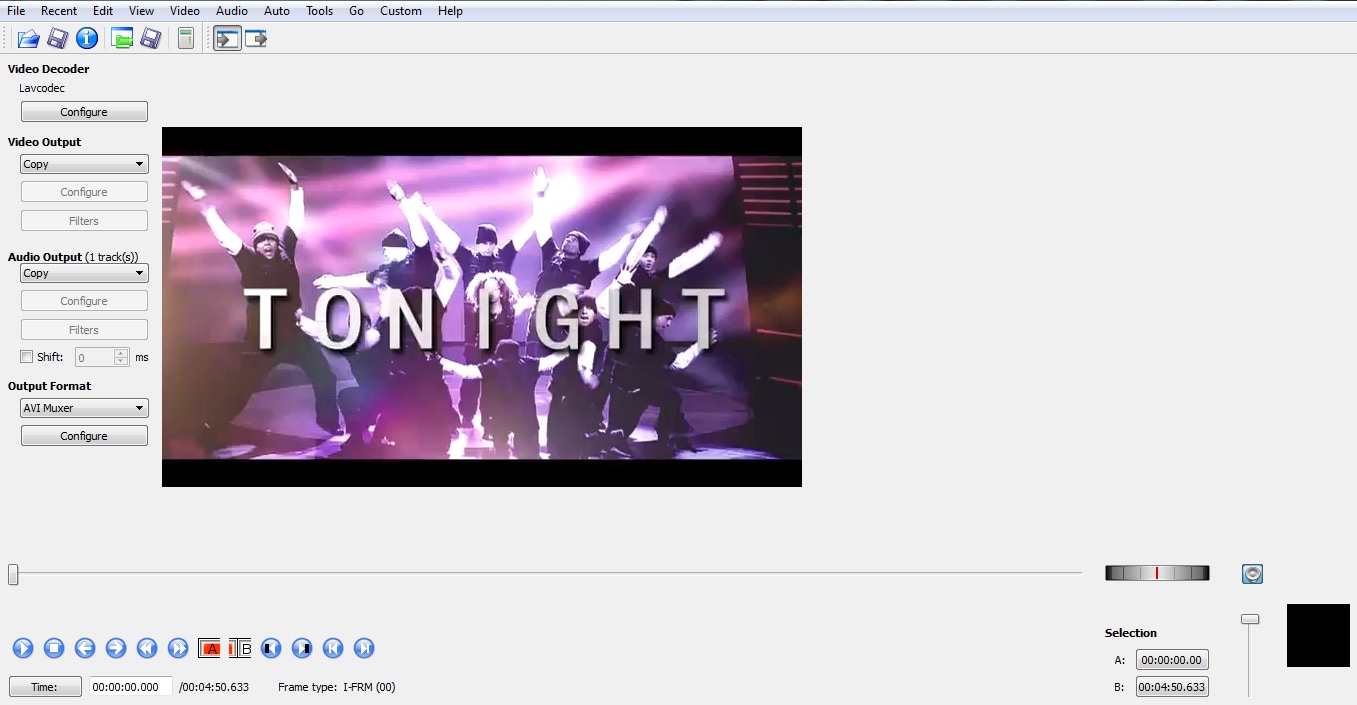
Now you can edit the video as you need, Avidemux contains a wealth of features to enable the full spectrum of editing tasks to be completed. However, here we are going to look at the cropping tool, so on to the next step.
3. Editing Video
Avidemux has some idiosyncrasies in terms of operation, one of those is that to be able to edit any video, you have to choose your output format. Don’t worry though, this is easy, just use the dropdown at the side to choose the output format you want as can be seen here.

Once that is set you are free to start editing your footage.
4. Cropping
It is important to understand how the editing process works in Avidemux, everything is accessed via the filters menu Video>Filters and from here you are faced with a new interface that enables you to choose the component you wish to use.

Selecting ‘Crop’ from the menu and pressing the green plus symbol at the bottom activated the crop tool and presents you with yet another view that allows you to adjust the crop to your tastes.
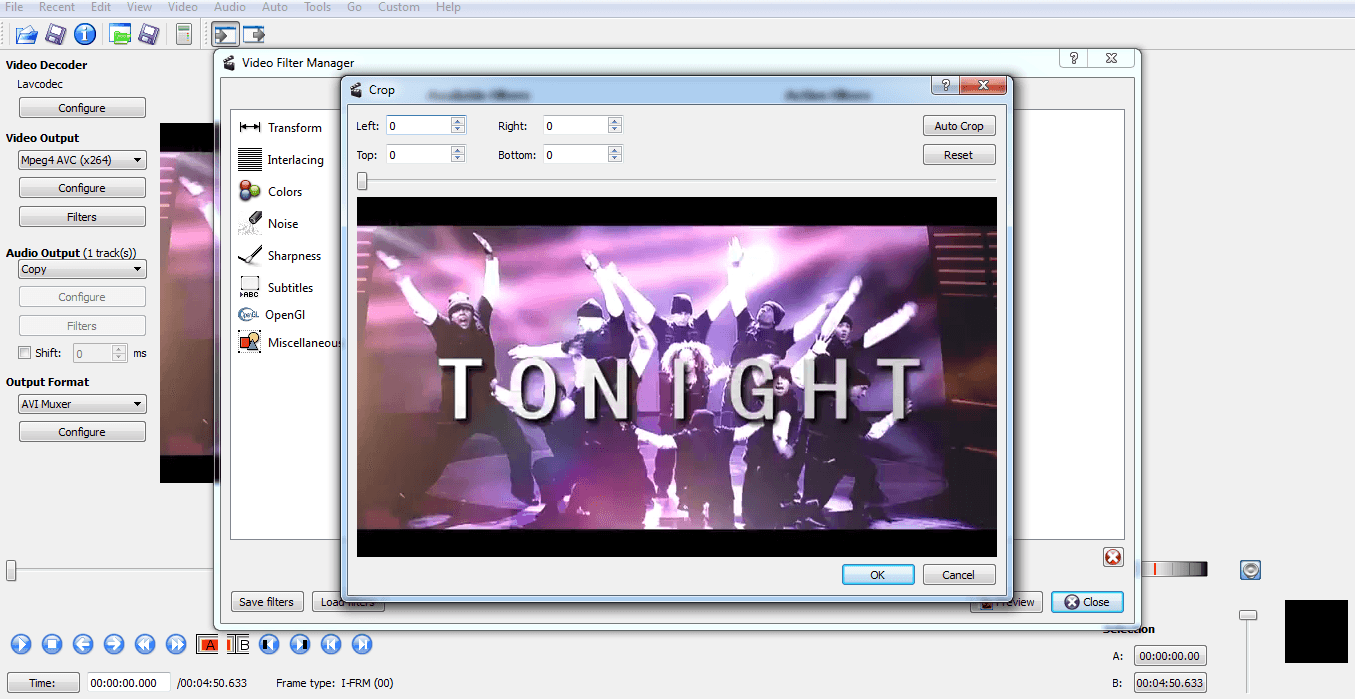
5. Cropping controls
There are two options for cropping, you can use the Auto crop feature, which will detect any black lines and crop the footage between them, or if you are using the crop tool for something else, or just want to do it manually, you can set the crop via the left right top and bottom boxes. Values input here are the number of pixels from that edge the crop extends, as you are setting it, this is displayed with a green block signifying the area of the image that will be removed.
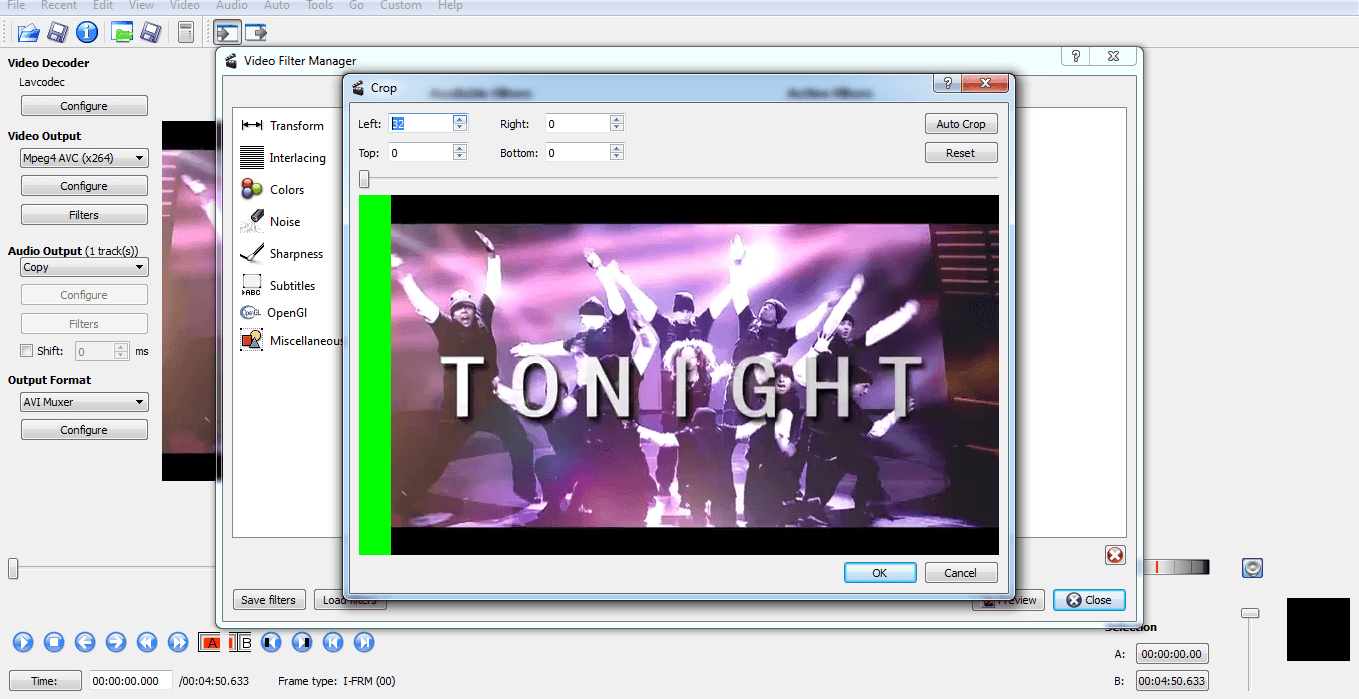
You can adjust this independently for all 4 edges as you wish.
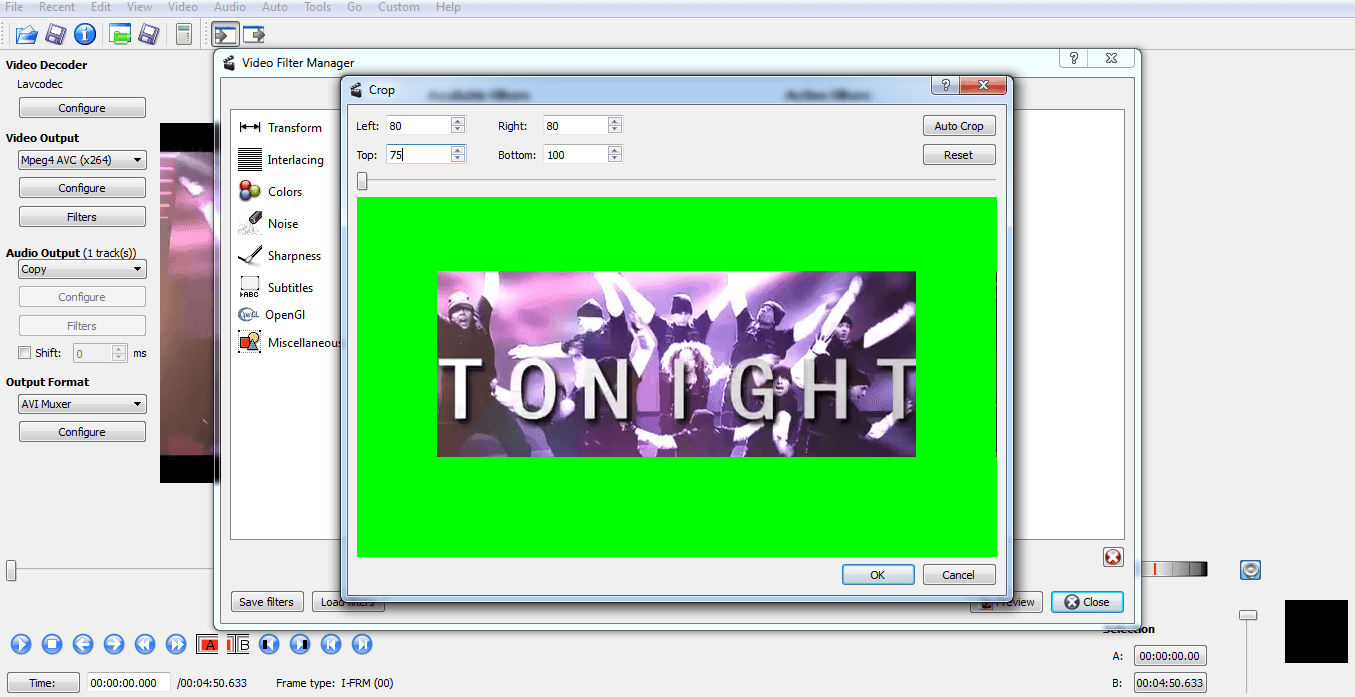
Once you are happy with the crop, you click Ok and it takes you back to the familiar filter menu where you can use other components to perform more editing if you need.
6. Saving the crop
One of the most common points of confusion with Avidemux comes at this point, as your video will look no different to when you started, and many think they have done something wrong, but this is another part of Avidemux workflow. These filters can only be applied when the video is reencoded, and you do that through the file>save menu.

Selecting this presents the familiar export dialogue and allows you to choose the name and destination of the file. Once that is done you click OK and you will see Avidemux processing your file and re-rendering it in this dialogue box.
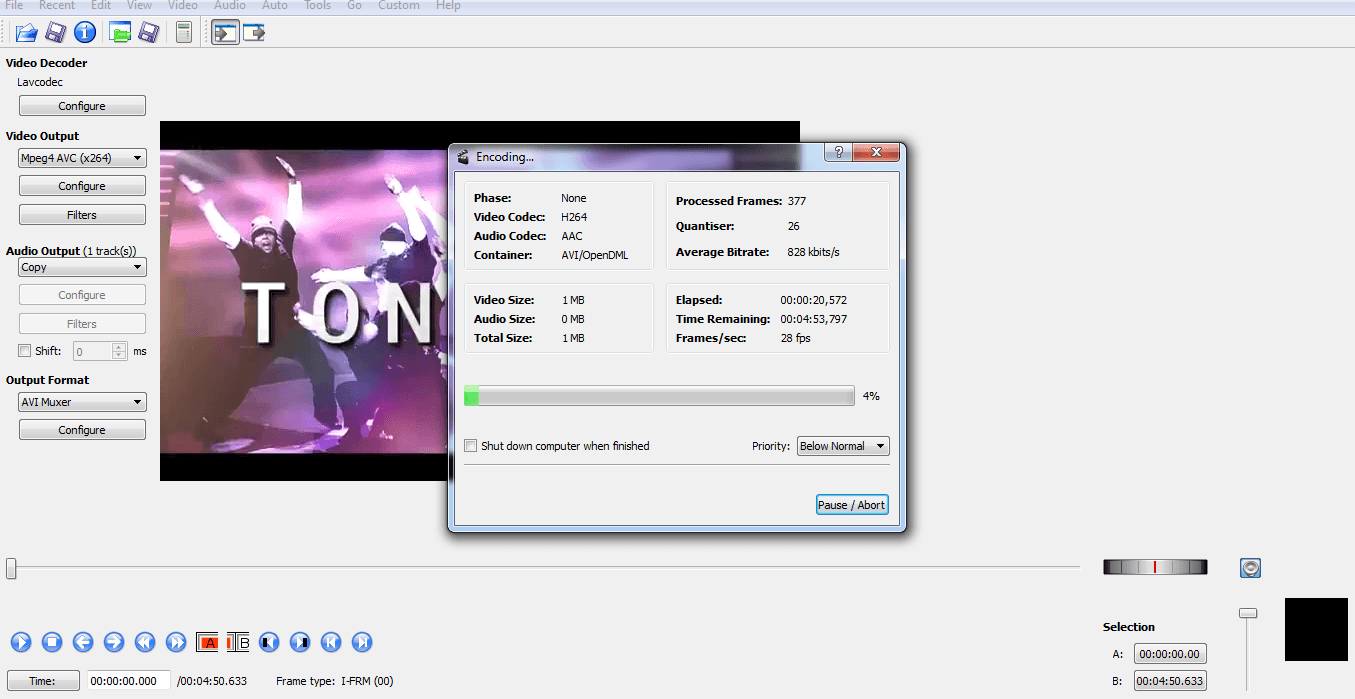
How long it takes will depend on a few factors, how many other effects have been added, how fast a processor your computer has, and how large and what resolution the video is. Format also plays a part in the process too, with some formats taking less time to encode than others. Once it has finished, you can view your video and see the crop in action.
As we can see, although there are a few aspects of the workflow that are a little unintuitive, cropping video in Avidemux is a straightforward process that anyone can accomplish with a bit of patience.
One of the key things to remember with Avidemux is that you apply all of your filters before re-encoding, this again is a question of patience and a bit of organization to ensure everything you wish to do is completed in order.
Avidemux is a great piece of software, it lacks the polish of some of its commercial rivals of course, but behind the sometimes clunky interface there is a very broad range of features that allow you to accomplish more or less any editing task you may want. In terms of free programs this is about as good as it gets, and the output is, without a doubt, great quality. For anyone looking for a free solution to video editing problems, and who do not mind a learning process Avidemux provides a useful tool.
An Easier Way to Crop a Video with Filmora
Filmora Video Editor is a powerful program that allows you to create stunning video clips in only a few clicks. This video editing software provides users with a variety of tools for editing videos. It also includes a user-friendly interface for editing home films on Windows PCs, Macs, and Linux devices. To crop a video, these are to follow:
Step 1: Open a video that you want to edit. Go to “Import” and choose the file that you want to upload and put it in the Media Library.
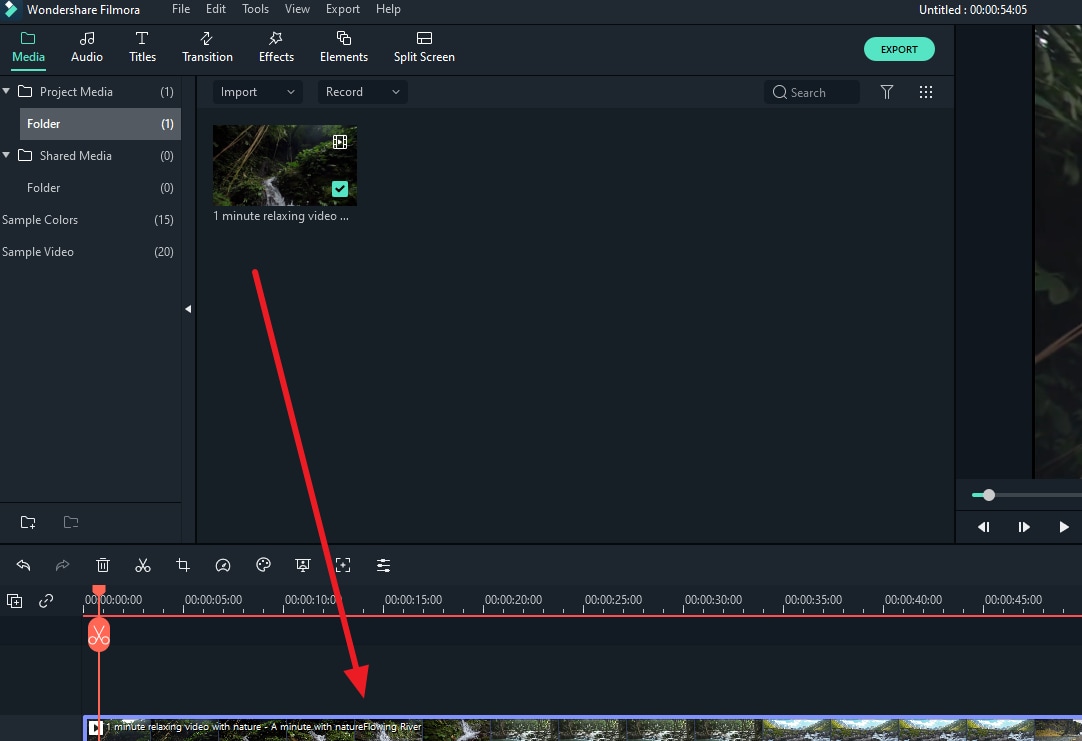
Step 2: Select the “Crop and Zoom” icon in the Filmora editing tool.
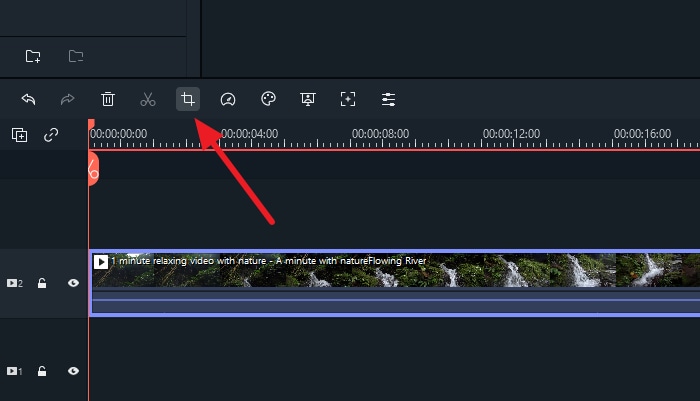
Step 3: To alter the size of the crop frame, drag the pointer from any corner of your video preview window.
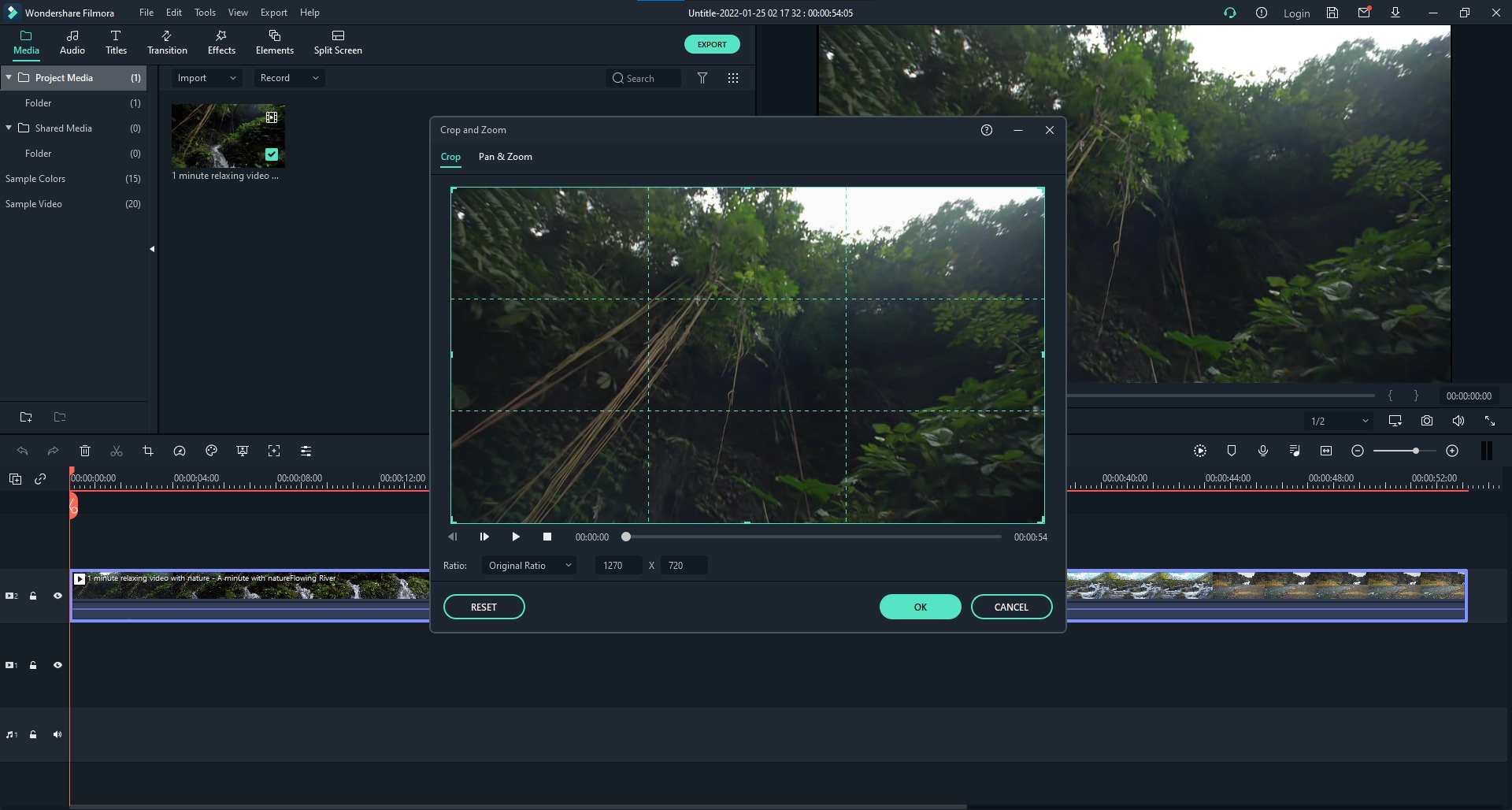
Step 4: When you’ve changed it to your liking, click the green “OK” button. As a result, you may effortlessly add or remove any element of a video clip on Filmora.


Ollie Mattison
Ollie Mattison is a writer and a lover of all things video.
Follow @Ollie Mattison
Ollie Mattison
Mar 27, 2024• Proven solutions
Cropping a video, to bring focus onto the important aspects and remove the extraneous parts of the scene, is one of the most valuable tools available to a video editor. It can be used as mentioned to ensure the viewer focuses on what is important, but also to magnify objects on the screen, such as with footage of nature. It has many uses, and one of the best tools available for cropping video is the free program Avidemux. Here we are going to go through the process of getting Avidemux running on your system and cropping some video.
If Avidemux is too complicate for you, you can consider Wondershare Filmora , which is an easy-to-use video editing tool to crop videos within several click. Download the free trial version blow.
 Download Mac Version ](https://tools.techidaily.com/wondershare/filmora/download/ )
Download Mac Version ](https://tools.techidaily.com/wondershare/filmora/download/ )
How to Crop a Video with Avidemux
1. Installation
You can find Avidemux for download here , it is available for a wide range of platforms, just download the version that fits your needs. Once downloaded, install in the standard way for your platform, this is the Wndows version (64bit).
One point of note during installation is that you can choose which parts of the program you wish to install. It is a very small footprint and for the best performance it is wise to simply install everything.

Once installed you will be presented with the program as seen here.

2. Importing Video
The next step is importing video. This can be done in two ways, by clicking the file folder icon at the top left you open a standard file browser to navigate to, and select your chosen video file, or alternatively you can simply drag you video into the main panel to import it.

Whichever route you take, you will end up with your video file loaded in like this.

Now you can edit the video as you need, Avidemux contains a wealth of features to enable the full spectrum of editing tasks to be completed. However, here we are going to look at the cropping tool, so on to the next step.
3. Editing Video
Avidemux has some idiosyncrasies in terms of operation, one of those is that to be able to edit any video, you have to choose your output format. Don’t worry though, this is easy, just use the dropdown at the side to choose the output format you want as can be seen here.

Once that is set you are free to start editing your footage.
4. Cropping
It is important to understand how the editing process works in Avidemux, everything is accessed via the filters menu Video>Filters and from here you are faced with a new interface that enables you to choose the component you wish to use.

Selecting ‘Crop’ from the menu and pressing the green plus symbol at the bottom activated the crop tool and presents you with yet another view that allows you to adjust the crop to your tastes.

5. Cropping controls
There are two options for cropping, you can use the Auto crop feature, which will detect any black lines and crop the footage between them, or if you are using the crop tool for something else, or just want to do it manually, you can set the crop via the left right top and bottom boxes. Values input here are the number of pixels from that edge the crop extends, as you are setting it, this is displayed with a green block signifying the area of the image that will be removed.

You can adjust this independently for all 4 edges as you wish.

Once you are happy with the crop, you click Ok and it takes you back to the familiar filter menu where you can use other components to perform more editing if you need.
6. Saving the crop
One of the most common points of confusion with Avidemux comes at this point, as your video will look no different to when you started, and many think they have done something wrong, but this is another part of Avidemux workflow. These filters can only be applied when the video is reencoded, and you do that through the file>save menu.

Selecting this presents the familiar export dialogue and allows you to choose the name and destination of the file. Once that is done you click OK and you will see Avidemux processing your file and re-rendering it in this dialogue box.

How long it takes will depend on a few factors, how many other effects have been added, how fast a processor your computer has, and how large and what resolution the video is. Format also plays a part in the process too, with some formats taking less time to encode than others. Once it has finished, you can view your video and see the crop in action.
As we can see, although there are a few aspects of the workflow that are a little unintuitive, cropping video in Avidemux is a straightforward process that anyone can accomplish with a bit of patience.
One of the key things to remember with Avidemux is that you apply all of your filters before re-encoding, this again is a question of patience and a bit of organization to ensure everything you wish to do is completed in order.
Avidemux is a great piece of software, it lacks the polish of some of its commercial rivals of course, but behind the sometimes clunky interface there is a very broad range of features that allow you to accomplish more or less any editing task you may want. In terms of free programs this is about as good as it gets, and the output is, without a doubt, great quality. For anyone looking for a free solution to video editing problems, and who do not mind a learning process Avidemux provides a useful tool.
An Easier Way to Crop a Video with Filmora
Filmora Video Editor is a powerful program that allows you to create stunning video clips in only a few clicks. This video editing software provides users with a variety of tools for editing videos. It also includes a user-friendly interface for editing home films on Windows PCs, Macs, and Linux devices. To crop a video, these are to follow:
Step 1: Open a video that you want to edit. Go to “Import” and choose the file that you want to upload and put it in the Media Library.

Step 2: Select the “Crop and Zoom” icon in the Filmora editing tool.

Step 3: To alter the size of the crop frame, drag the pointer from any corner of your video preview window.

Step 4: When you’ve changed it to your liking, click the green “OK” button. As a result, you may effortlessly add or remove any element of a video clip on Filmora.


Ollie Mattison
Ollie Mattison is a writer and a lover of all things video.
Follow @Ollie Mattison
Ollie Mattison
Mar 27, 2024• Proven solutions
Cropping a video, to bring focus onto the important aspects and remove the extraneous parts of the scene, is one of the most valuable tools available to a video editor. It can be used as mentioned to ensure the viewer focuses on what is important, but also to magnify objects on the screen, such as with footage of nature. It has many uses, and one of the best tools available for cropping video is the free program Avidemux. Here we are going to go through the process of getting Avidemux running on your system and cropping some video.
If Avidemux is too complicate for you, you can consider Wondershare Filmora , which is an easy-to-use video editing tool to crop videos within several click. Download the free trial version blow.
 Download Mac Version ](https://tools.techidaily.com/wondershare/filmora/download/ )
Download Mac Version ](https://tools.techidaily.com/wondershare/filmora/download/ )
How to Crop a Video with Avidemux
1. Installation
You can find Avidemux for download here , it is available for a wide range of platforms, just download the version that fits your needs. Once downloaded, install in the standard way for your platform, this is the Wndows version (64bit).
One point of note during installation is that you can choose which parts of the program you wish to install. It is a very small footprint and for the best performance it is wise to simply install everything.

Once installed you will be presented with the program as seen here.

2. Importing Video
The next step is importing video. This can be done in two ways, by clicking the file folder icon at the top left you open a standard file browser to navigate to, and select your chosen video file, or alternatively you can simply drag you video into the main panel to import it.

Whichever route you take, you will end up with your video file loaded in like this.

Now you can edit the video as you need, Avidemux contains a wealth of features to enable the full spectrum of editing tasks to be completed. However, here we are going to look at the cropping tool, so on to the next step.
3. Editing Video
Avidemux has some idiosyncrasies in terms of operation, one of those is that to be able to edit any video, you have to choose your output format. Don’t worry though, this is easy, just use the dropdown at the side to choose the output format you want as can be seen here.

Once that is set you are free to start editing your footage.
4. Cropping
It is important to understand how the editing process works in Avidemux, everything is accessed via the filters menu Video>Filters and from here you are faced with a new interface that enables you to choose the component you wish to use.

Selecting ‘Crop’ from the menu and pressing the green plus symbol at the bottom activated the crop tool and presents you with yet another view that allows you to adjust the crop to your tastes.

5. Cropping controls
There are two options for cropping, you can use the Auto crop feature, which will detect any black lines and crop the footage between them, or if you are using the crop tool for something else, or just want to do it manually, you can set the crop via the left right top and bottom boxes. Values input here are the number of pixels from that edge the crop extends, as you are setting it, this is displayed with a green block signifying the area of the image that will be removed.

You can adjust this independently for all 4 edges as you wish.

Once you are happy with the crop, you click Ok and it takes you back to the familiar filter menu where you can use other components to perform more editing if you need.
6. Saving the crop
One of the most common points of confusion with Avidemux comes at this point, as your video will look no different to when you started, and many think they have done something wrong, but this is another part of Avidemux workflow. These filters can only be applied when the video is reencoded, and you do that through the file>save menu.

Selecting this presents the familiar export dialogue and allows you to choose the name and destination of the file. Once that is done you click OK and you will see Avidemux processing your file and re-rendering it in this dialogue box.

How long it takes will depend on a few factors, how many other effects have been added, how fast a processor your computer has, and how large and what resolution the video is. Format also plays a part in the process too, with some formats taking less time to encode than others. Once it has finished, you can view your video and see the crop in action.
As we can see, although there are a few aspects of the workflow that are a little unintuitive, cropping video in Avidemux is a straightforward process that anyone can accomplish with a bit of patience.
One of the key things to remember with Avidemux is that you apply all of your filters before re-encoding, this again is a question of patience and a bit of organization to ensure everything you wish to do is completed in order.
Avidemux is a great piece of software, it lacks the polish of some of its commercial rivals of course, but behind the sometimes clunky interface there is a very broad range of features that allow you to accomplish more or less any editing task you may want. In terms of free programs this is about as good as it gets, and the output is, without a doubt, great quality. For anyone looking for a free solution to video editing problems, and who do not mind a learning process Avidemux provides a useful tool.
An Easier Way to Crop a Video with Filmora
Filmora Video Editor is a powerful program that allows you to create stunning video clips in only a few clicks. This video editing software provides users with a variety of tools for editing videos. It also includes a user-friendly interface for editing home films on Windows PCs, Macs, and Linux devices. To crop a video, these are to follow:
Step 1: Open a video that you want to edit. Go to “Import” and choose the file that you want to upload and put it in the Media Library.

Step 2: Select the “Crop and Zoom” icon in the Filmora editing tool.

Step 3: To alter the size of the crop frame, drag the pointer from any corner of your video preview window.

Step 4: When you’ve changed it to your liking, click the green “OK” button. As a result, you may effortlessly add or remove any element of a video clip on Filmora.


Ollie Mattison
Ollie Mattison is a writer and a lover of all things video.
Follow @Ollie Mattison
Ollie Mattison
Mar 27, 2024• Proven solutions
Cropping a video, to bring focus onto the important aspects and remove the extraneous parts of the scene, is one of the most valuable tools available to a video editor. It can be used as mentioned to ensure the viewer focuses on what is important, but also to magnify objects on the screen, such as with footage of nature. It has many uses, and one of the best tools available for cropping video is the free program Avidemux. Here we are going to go through the process of getting Avidemux running on your system and cropping some video.
If Avidemux is too complicate for you, you can consider Wondershare Filmora , which is an easy-to-use video editing tool to crop videos within several click. Download the free trial version blow.
 Download Mac Version ](https://tools.techidaily.com/wondershare/filmora/download/ )
Download Mac Version ](https://tools.techidaily.com/wondershare/filmora/download/ )
How to Crop a Video with Avidemux
1. Installation
You can find Avidemux for download here , it is available for a wide range of platforms, just download the version that fits your needs. Once downloaded, install in the standard way for your platform, this is the Wndows version (64bit).
One point of note during installation is that you can choose which parts of the program you wish to install. It is a very small footprint and for the best performance it is wise to simply install everything.

Once installed you will be presented with the program as seen here.

2. Importing Video
The next step is importing video. This can be done in two ways, by clicking the file folder icon at the top left you open a standard file browser to navigate to, and select your chosen video file, or alternatively you can simply drag you video into the main panel to import it.

Whichever route you take, you will end up with your video file loaded in like this.

Now you can edit the video as you need, Avidemux contains a wealth of features to enable the full spectrum of editing tasks to be completed. However, here we are going to look at the cropping tool, so on to the next step.
3. Editing Video
Avidemux has some idiosyncrasies in terms of operation, one of those is that to be able to edit any video, you have to choose your output format. Don’t worry though, this is easy, just use the dropdown at the side to choose the output format you want as can be seen here.

Once that is set you are free to start editing your footage.
4. Cropping
It is important to understand how the editing process works in Avidemux, everything is accessed via the filters menu Video>Filters and from here you are faced with a new interface that enables you to choose the component you wish to use.

Selecting ‘Crop’ from the menu and pressing the green plus symbol at the bottom activated the crop tool and presents you with yet another view that allows you to adjust the crop to your tastes.

5. Cropping controls
There are two options for cropping, you can use the Auto crop feature, which will detect any black lines and crop the footage between them, or if you are using the crop tool for something else, or just want to do it manually, you can set the crop via the left right top and bottom boxes. Values input here are the number of pixels from that edge the crop extends, as you are setting it, this is displayed with a green block signifying the area of the image that will be removed.

You can adjust this independently for all 4 edges as you wish.

Once you are happy with the crop, you click Ok and it takes you back to the familiar filter menu where you can use other components to perform more editing if you need.
6. Saving the crop
One of the most common points of confusion with Avidemux comes at this point, as your video will look no different to when you started, and many think they have done something wrong, but this is another part of Avidemux workflow. These filters can only be applied when the video is reencoded, and you do that through the file>save menu.

Selecting this presents the familiar export dialogue and allows you to choose the name and destination of the file. Once that is done you click OK and you will see Avidemux processing your file and re-rendering it in this dialogue box.

How long it takes will depend on a few factors, how many other effects have been added, how fast a processor your computer has, and how large and what resolution the video is. Format also plays a part in the process too, with some formats taking less time to encode than others. Once it has finished, you can view your video and see the crop in action.
As we can see, although there are a few aspects of the workflow that are a little unintuitive, cropping video in Avidemux is a straightforward process that anyone can accomplish with a bit of patience.
One of the key things to remember with Avidemux is that you apply all of your filters before re-encoding, this again is a question of patience and a bit of organization to ensure everything you wish to do is completed in order.
Avidemux is a great piece of software, it lacks the polish of some of its commercial rivals of course, but behind the sometimes clunky interface there is a very broad range of features that allow you to accomplish more or less any editing task you may want. In terms of free programs this is about as good as it gets, and the output is, without a doubt, great quality. For anyone looking for a free solution to video editing problems, and who do not mind a learning process Avidemux provides a useful tool.
An Easier Way to Crop a Video with Filmora
Filmora Video Editor is a powerful program that allows you to create stunning video clips in only a few clicks. This video editing software provides users with a variety of tools for editing videos. It also includes a user-friendly interface for editing home films on Windows PCs, Macs, and Linux devices. To crop a video, these are to follow:
Step 1: Open a video that you want to edit. Go to “Import” and choose the file that you want to upload and put it in the Media Library.

Step 2: Select the “Crop and Zoom” icon in the Filmora editing tool.

Step 3: To alter the size of the crop frame, drag the pointer from any corner of your video preview window.

Step 4: When you’ve changed it to your liking, click the green “OK” button. As a result, you may effortlessly add or remove any element of a video clip on Filmora.


Ollie Mattison
Ollie Mattison is a writer and a lover of all things video.
Follow @Ollie Mattison
Chrome OS Video Editing: The Best Free Alternatives
Wodershare Filmora
Filmora is one of the most popular video editing software among YouTubers, download and have a try.
Chromebooks are controlled by the ChromeOS working framework, which runs most applications on the web and saves everything on the cloud. Most Chromebooks don’t have incredible assets and components to operate heavy tasks like professional video editing.
However, various video editors for Chromebooks have been developed to carry out these tasks. Some of these video editors for Chromebook are mobile-based apps - supported by iOS and Android, while others are web-based. In this article, we’ll provide you with free editing software for Chromebook that you can use to edit your videos.
Best Free Video Editor for Chromebook in 2022
2. Kapwing
Kapwing is a free online video editor that allows users to record, edit and collaborate on videos with lots of tools. You can use it to create a video from scratch by uploading images, videos, and audio files to its workspace.
Besides that, you can add subtitles to any video easily online with Kapwing, or resize, trim, flip or rotate the video. It also provides some professional video templates for YouTube, Instagram, Ad & Sales, and TikTok, which allows you to create a video quickly and easily. All these features make it a good choice for Chromebook users.
Why you should try Kapwing on Chromebook?
- It allows you to upload media files from Chromebook, or paste a Google Drive, Google Photos, or paste a link from YouTube. What’s more, it also provides some samples to try in case you didn’t want to upload your file.
- You can use it to record, edit and share videos in one place, which saves you much time.
- It provides almost all basic video editing tools that people may need to make a video, such as adding layers, titles, elements, and audio, trimming, cropping, adjusting colors, and changing speed and aspect ratios .
- As free users, you can register and sign in to remove the watermark on videos under 5 minutes.
Pros
- Provides lots of editing tools with an intuitive interface, user-friendly, and simple to use.
- Features easy-to-use settings, entertaining themes, and automatic subtitles. It’s an excellent resource for both new and seasoned video creators.
- Automatically generate subtitles on a video which improves editing efficiency.
Cons
- Glitches in AI auto-generated subtitles.
- Limits to file sizes on the free version (up to 250MB)
- Export to 720p in free version
3. WeVideo
WeVideo is one of the leading online free video editors. It allows the user to create videos anywhere and anytime. You can find this app on App Store, Google Play, and Chrome Web Store. This video editor for Chromebook provides 1 million pieces of stock media, including videos, images, and music tracks.
Using WeVideo online video editor, you can create a square, horizontal, or vertical video for educational, school, business, and family.
Why you should try WeVideo to edit videos on Chromebook?
- It provides more uploading options: besides Google Drive and Dropbox you can import media files from social sites such as Facebook and Instagram;
- You can use it to record narrations, the Chromebook screen and webcam, and edit the recorded video for the remote learning or webinar.
- There are some video backgrounds and music tracks libraries which allows you to use these stock assets directly.
- Collaboration: Students can work together on movies, podcasts, presentations, and more in real-time.
Pros
- Good editing and creation features such as themes, titles, fonts, and green screen options.
- Features user-friendly interfaces and it is simple to use.
- Provides lots of backgrounds, music tracks, sound effects, overlays, and frames.
Cons
- Recording screen and webcam simultaneously is available for paid users only.
- Registered users can only publish a 5-minute video at 480p video resolution with a watermark.
4. YouTube Studio Video Editor 
YouTube Studio Video Editor is a platform that allows users, mainly YouTubers, to create and edit videos. It enables users who are new to video production or do not have access to video editing tools to perform basic editing. It is the best choice for YouTube content creators as you create and edit your videos, manage your presence and interact with your audience with ease. To begin, go to studio.youtube.com, upload a video, and start editing.
Why editing videos with YouTube Studio video editor on Chromebook?
- It provides some basic video editing tools such as trimming part of the video.
- You can use it to blur parts of the video with face blur or custom blur to hide some sensitive information.
- It’s totally free for all YouTube users.
Pros
- It is free and has a vast library of free music tracks and sound effects.
- There will be no watermarks at the video.
- Simple and easy to learn.
- Users have access to all the videos uploaded to YouTube.
Cons
- It has some basic editing features only.
- You can’t merger several video clips into one.
5. Adobe Spark Video
Adobe Spark Video is another exciting free editing software for Chromebook that allows users to add video clips to the library, choose a preferred theme, edit, download, and share to various platforms online. It’s from Adobe, a big name in video editing software.
With this online video maker, you can resize, crop, trim, merger, reverse videos easily, and change the video speed to make a slow motion or fast forward effect.
Main features in editing videos in Chromebook:
- Provides some basic video editing tools such as trim, merge and resize.
- You can add images, music and text to your videos with it.
- Preformatted story templates for different types of videos.
- Offers a 14-day free trial, and a paid version.
Pros
- Simple and intuitive interface
- Accessible templates
- Logos and colors are automatically filled in with branding preset, which saves a lot of work.
- Designs are relevant and up-to-date.
Cons
- Limited options when selecting a color palette for a design.
- The audio feature does not allow continuous recording.
- Watermarks exist in free versions.
6. Clipchamp
Clipchamp is a browser-based video editor that allows the user to explore a multi-layer video editing timeline. This online video editor provides some ready-to-use templates, and a stock media library which includes both footage and audio files. What’s more, it provides a flexible and fast video editing experience in video recording, editing, compressing, and converting.
Main features of using Clipchamp on Chromebooks:
- Multi-layer video editing allows you to create a PIP style video easily
- It allows you to record your webcam and your screen at the same time, and upload from online source or from desktop
- Offers free and paid versions; however, there are watermarks in the free version which you can remove by getting the paid version.
Pros
- Works seamlessly with cloud storage providers such as OneDrive and Dropbox.
- Compatible with Giphy and stock content libraries.
- Features the text to speech tool to generate narration automatically .
- It has an easy-to-understand user interface.
Cons
- Free version is limited to export at 480p resolution with watermark included.
7. Magisto
Magisto is one of the popular free editing apps for Chromebook that transforms your films into original movies. The mobile app analyzes the films and selects the most engaging segments using artificial intelligence.
Main features of using Magisto on Chromebook :
- Multiple themes.
- Edit and rearrange scenes.
- Add logos and captions.
- Premium editing styles.
- Unlimited HD movie downloads
- Offers free and paid versions
Pros:
- Super easy to use, great options for templates
- Provides options to add themes, music, and styles.
- Videos can be hosted, downloaded, and shared all within the same platform.
Cons:
- Only Pro plan offers Full HD recording.
- It does not support Image editing.
- Video analytics are available only in the most expensive plan.
8. Kizoa
Kizoa is a cloud-based platform that allows the user to work on any project anywhere. This free video editor for Chromebook enables the user to submit and edit videos without downloading anything.
Main features of Kizoa:
- Pre-made video templates.
- Access to an integrated royalty-free photo library.
- Integrated music and special effects.
- Various text and transition options.
- Offer free and paid versions.
- No watermarks
Pros
- Animation and Text tools are easy to alter
- Easy to understand the sign-up procedure.
- Users can also change the aspect ratio of videos.
Cons
- Complicated User interface
- Free versions have limited features.
- Full HD recording is only available with the paid version.
9. Kdenlive
Kdenlive is a user-friendly open-source video editor but you can use it on Chromebook computers. It’s a popular non-linear video editor that offers one of the greatest multi-track editing timelines.
Main features of Kdenlive:
- Supports multi-track editing
- Custom effects and transitions.
- Customizable user interface and shortcuts.
- Free for all users.
- No watermarks.
Pros
- Efficient in creating montage videos.
- Animation and Subtitle keyframe features.
- Color correction tools
- Support rotoscoping.
Cons
- Speed effect is low
- Limited output options.
10. Kinemaster
Kinemaster is a free editing app for Android and iOS users, but it can be used on Chromebooks as well. It combines a well-designed interface, a fantastic user experience, and a wide range of powerful tools, which makes video editing is easy and fun.
Main features of KineMaster:
- It supports high resolution video editing, for example, 4K videos at up to 60 frames per second.
- It provides both basic and professional editing tools.
- 8 different blending options to create video with effect in a magic way.
- You can backup the project, or share it to others to co-edit it.
Pros
- The KineMaster Asset Stores provides effects, music, stickers and fonts, which is very useful.
- Features some professional editing tools such as chrome key, blending mode,
- Provides projects which allows you to download and use in your device directly to re-edit further.
Cons:
- Free version will leave a watermark
11. CapCut
CapCut is a free and all-in-one video editing app for Android and iOS devices, but it can also be used on Chromebooks as well just like Kinemaster. It supports a wide range of file types and has all of the standard editing tools.
Main features of CapCut:
- It provides some video editing tools such as split, change speed, reverse and rotate.
- It has a tremendous music library which includes top music hits and sound effect.
- It allows you to add trending stickers, texts and titles without any efforts.
- It’s free for all users with a removable watermark, which can be removed easily.
Pros
- Convenient and easy to use.
- Impressive music and sound effects library
Cons:
- Only one video and audio track
Conclusion
It’s essential every user becomes familiar with the various free video editing software for Chromebook because if your preferred video editor for Chromebook is unable to meet your needs, or if Adobe video editing software is too difficult to master, you can try another alternate solution and get the most out of it.
Chromebooks are controlled by the ChromeOS working framework, which runs most applications on the web and saves everything on the cloud. Most Chromebooks don’t have incredible assets and components to operate heavy tasks like professional video editing.
However, various video editors for Chromebooks have been developed to carry out these tasks. Some of these video editors for Chromebook are mobile-based apps - supported by iOS and Android, while others are web-based. In this article, we’ll provide you with free editing software for Chromebook that you can use to edit your videos.
Best Free Video Editor for Chromebook in 2022
2. Kapwing
Kapwing is a free online video editor that allows users to record, edit and collaborate on videos with lots of tools. You can use it to create a video from scratch by uploading images, videos, and audio files to its workspace.
Besides that, you can add subtitles to any video easily online with Kapwing, or resize, trim, flip or rotate the video. It also provides some professional video templates for YouTube, Instagram, Ad & Sales, and TikTok, which allows you to create a video quickly and easily. All these features make it a good choice for Chromebook users.
Why you should try Kapwing on Chromebook?
- It allows you to upload media files from Chromebook, or paste a Google Drive, Google Photos, or paste a link from YouTube. What’s more, it also provides some samples to try in case you didn’t want to upload your file.
- You can use it to record, edit and share videos in one place, which saves you much time.
- It provides almost all basic video editing tools that people may need to make a video, such as adding layers, titles, elements, and audio, trimming, cropping, adjusting colors, and changing speed and aspect ratios .
- As free users, you can register and sign in to remove the watermark on videos under 5 minutes.
Pros
- Provides lots of editing tools with an intuitive interface, user-friendly, and simple to use.
- Features easy-to-use settings, entertaining themes, and automatic subtitles. It’s an excellent resource for both new and seasoned video creators.
- Automatically generate subtitles on a video which improves editing efficiency.
Cons
- Glitches in AI auto-generated subtitles.
- Limits to file sizes on the free version (up to 250MB)
- Export to 720p in free version
3. WeVideo
WeVideo is one of the leading online free video editors. It allows the user to create videos anywhere and anytime. You can find this app on App Store, Google Play, and Chrome Web Store. This video editor for Chromebook provides 1 million pieces of stock media, including videos, images, and music tracks.
Using WeVideo online video editor, you can create a square, horizontal, or vertical video for educational, school, business, and family.
Why you should try WeVideo to edit videos on Chromebook?
- It provides more uploading options: besides Google Drive and Dropbox you can import media files from social sites such as Facebook and Instagram;
- You can use it to record narrations, the Chromebook screen and webcam, and edit the recorded video for the remote learning or webinar.
- There are some video backgrounds and music tracks libraries which allows you to use these stock assets directly.
- Collaboration: Students can work together on movies, podcasts, presentations, and more in real-time.
Pros
- Good editing and creation features such as themes, titles, fonts, and green screen options.
- Features user-friendly interfaces and it is simple to use.
- Provides lots of backgrounds, music tracks, sound effects, overlays, and frames.
Cons
- Recording screen and webcam simultaneously is available for paid users only.
- Registered users can only publish a 5-minute video at 480p video resolution with a watermark.
4. YouTube Studio Video Editor 
YouTube Studio Video Editor is a platform that allows users, mainly YouTubers, to create and edit videos. It enables users who are new to video production or do not have access to video editing tools to perform basic editing. It is the best choice for YouTube content creators as you create and edit your videos, manage your presence and interact with your audience with ease. To begin, go to studio.youtube.com, upload a video, and start editing.
Why editing videos with YouTube Studio video editor on Chromebook?
- It provides some basic video editing tools such as trimming part of the video.
- You can use it to blur parts of the video with face blur or custom blur to hide some sensitive information.
- It’s totally free for all YouTube users.
Pros
- It is free and has a vast library of free music tracks and sound effects.
- There will be no watermarks at the video.
- Simple and easy to learn.
- Users have access to all the videos uploaded to YouTube.
Cons
- It has some basic editing features only.
- You can’t merger several video clips into one.
5. Adobe Spark Video
Adobe Spark Video is another exciting free editing software for Chromebook that allows users to add video clips to the library, choose a preferred theme, edit, download, and share to various platforms online. It’s from Adobe, a big name in video editing software.
With this online video maker, you can resize, crop, trim, merger, reverse videos easily, and change the video speed to make a slow motion or fast forward effect.
Main features in editing videos in Chromebook:
- Provides some basic video editing tools such as trim, merge and resize.
- You can add images, music and text to your videos with it.
- Preformatted story templates for different types of videos.
- Offers a 14-day free trial, and a paid version.
Pros
- Simple and intuitive interface
- Accessible templates
- Logos and colors are automatically filled in with branding preset, which saves a lot of work.
- Designs are relevant and up-to-date.
Cons
- Limited options when selecting a color palette for a design.
- The audio feature does not allow continuous recording.
- Watermarks exist in free versions.
6. Clipchamp
Clipchamp is a browser-based video editor that allows the user to explore a multi-layer video editing timeline. This online video editor provides some ready-to-use templates, and a stock media library which includes both footage and audio files. What’s more, it provides a flexible and fast video editing experience in video recording, editing, compressing, and converting.
Main features of using Clipchamp on Chromebooks:
- Multi-layer video editing allows you to create a PIP style video easily
- It allows you to record your webcam and your screen at the same time, and upload from online source or from desktop
- Offers free and paid versions; however, there are watermarks in the free version which you can remove by getting the paid version.
Pros
- Works seamlessly with cloud storage providers such as OneDrive and Dropbox.
- Compatible with Giphy and stock content libraries.
- Features the text to speech tool to generate narration automatically .
- It has an easy-to-understand user interface.
Cons
- Free version is limited to export at 480p resolution with watermark included.
7. Magisto
Magisto is one of the popular free editing apps for Chromebook that transforms your films into original movies. The mobile app analyzes the films and selects the most engaging segments using artificial intelligence.
Main features of using Magisto on Chromebook :
- Multiple themes.
- Edit and rearrange scenes.
- Add logos and captions.
- Premium editing styles.
- Unlimited HD movie downloads
- Offers free and paid versions
Pros:
- Super easy to use, great options for templates
- Provides options to add themes, music, and styles.
- Videos can be hosted, downloaded, and shared all within the same platform.
Cons:
- Only Pro plan offers Full HD recording.
- It does not support Image editing.
- Video analytics are available only in the most expensive plan.
8. Kizoa
Kizoa is a cloud-based platform that allows the user to work on any project anywhere. This free video editor for Chromebook enables the user to submit and edit videos without downloading anything.
Main features of Kizoa:
- Pre-made video templates.
- Access to an integrated royalty-free photo library.
- Integrated music and special effects.
- Various text and transition options.
- Offer free and paid versions.
- No watermarks
Pros
- Animation and Text tools are easy to alter
- Easy to understand the sign-up procedure.
- Users can also change the aspect ratio of videos.
Cons
- Complicated User interface
- Free versions have limited features.
- Full HD recording is only available with the paid version.
9. Kdenlive
Kdenlive is a user-friendly open-source video editor but you can use it on Chromebook computers. It’s a popular non-linear video editor that offers one of the greatest multi-track editing timelines.
Main features of Kdenlive:
- Supports multi-track editing
- Custom effects and transitions.
- Customizable user interface and shortcuts.
- Free for all users.
- No watermarks.
Pros
- Efficient in creating montage videos.
- Animation and Subtitle keyframe features.
- Color correction tools
- Support rotoscoping.
Cons
- Speed effect is low
- Limited output options.
10. Kinemaster
Kinemaster is a free editing app for Android and iOS users, but it can be used on Chromebooks as well. It combines a well-designed interface, a fantastic user experience, and a wide range of powerful tools, which makes video editing is easy and fun.
Main features of KineMaster:
- It supports high resolution video editing, for example, 4K videos at up to 60 frames per second.
- It provides both basic and professional editing tools.
- 8 different blending options to create video with effect in a magic way.
- You can backup the project, or share it to others to co-edit it.
Pros
- The KineMaster Asset Stores provides effects, music, stickers and fonts, which is very useful.
- Features some professional editing tools such as chrome key, blending mode,
- Provides projects which allows you to download and use in your device directly to re-edit further.
Cons:
- Free version will leave a watermark
11. CapCut
CapCut is a free and all-in-one video editing app for Android and iOS devices, but it can also be used on Chromebooks as well just like Kinemaster. It supports a wide range of file types and has all of the standard editing tools.
Main features of CapCut:
- It provides some video editing tools such as split, change speed, reverse and rotate.
- It has a tremendous music library which includes top music hits and sound effect.
- It allows you to add trending stickers, texts and titles without any efforts.
- It’s free for all users with a removable watermark, which can be removed easily.
Pros
- Convenient and easy to use.
- Impressive music and sound effects library
Cons:
- Only one video and audio track
Conclusion
It’s essential every user becomes familiar with the various free video editing software for Chromebook because if your preferred video editor for Chromebook is unable to meet your needs, or if Adobe video editing software is too difficult to master, you can try another alternate solution and get the most out of it.
Chromebooks are controlled by the ChromeOS working framework, which runs most applications on the web and saves everything on the cloud. Most Chromebooks don’t have incredible assets and components to operate heavy tasks like professional video editing.
However, various video editors for Chromebooks have been developed to carry out these tasks. Some of these video editors for Chromebook are mobile-based apps - supported by iOS and Android, while others are web-based. In this article, we’ll provide you with free editing software for Chromebook that you can use to edit your videos.
Best Free Video Editor for Chromebook in 2022
2. Kapwing
Kapwing is a free online video editor that allows users to record, edit and collaborate on videos with lots of tools. You can use it to create a video from scratch by uploading images, videos, and audio files to its workspace.
Besides that, you can add subtitles to any video easily online with Kapwing, or resize, trim, flip or rotate the video. It also provides some professional video templates for YouTube, Instagram, Ad & Sales, and TikTok, which allows you to create a video quickly and easily. All these features make it a good choice for Chromebook users.
Why you should try Kapwing on Chromebook?
- It allows you to upload media files from Chromebook, or paste a Google Drive, Google Photos, or paste a link from YouTube. What’s more, it also provides some samples to try in case you didn’t want to upload your file.
- You can use it to record, edit and share videos in one place, which saves you much time.
- It provides almost all basic video editing tools that people may need to make a video, such as adding layers, titles, elements, and audio, trimming, cropping, adjusting colors, and changing speed and aspect ratios .
- As free users, you can register and sign in to remove the watermark on videos under 5 minutes.
Pros
- Provides lots of editing tools with an intuitive interface, user-friendly, and simple to use.
- Features easy-to-use settings, entertaining themes, and automatic subtitles. It’s an excellent resource for both new and seasoned video creators.
- Automatically generate subtitles on a video which improves editing efficiency.
Cons
- Glitches in AI auto-generated subtitles.
- Limits to file sizes on the free version (up to 250MB)
- Export to 720p in free version
3. WeVideo
WeVideo is one of the leading online free video editors. It allows the user to create videos anywhere and anytime. You can find this app on App Store, Google Play, and Chrome Web Store. This video editor for Chromebook provides 1 million pieces of stock media, including videos, images, and music tracks.
Using WeVideo online video editor, you can create a square, horizontal, or vertical video for educational, school, business, and family.
Why you should try WeVideo to edit videos on Chromebook?
- It provides more uploading options: besides Google Drive and Dropbox you can import media files from social sites such as Facebook and Instagram;
- You can use it to record narrations, the Chromebook screen and webcam, and edit the recorded video for the remote learning or webinar.
- There are some video backgrounds and music tracks libraries which allows you to use these stock assets directly.
- Collaboration: Students can work together on movies, podcasts, presentations, and more in real-time.
Pros
- Good editing and creation features such as themes, titles, fonts, and green screen options.
- Features user-friendly interfaces and it is simple to use.
- Provides lots of backgrounds, music tracks, sound effects, overlays, and frames.
Cons
- Recording screen and webcam simultaneously is available for paid users only.
- Registered users can only publish a 5-minute video at 480p video resolution with a watermark.
4. YouTube Studio Video Editor 
YouTube Studio Video Editor is a platform that allows users, mainly YouTubers, to create and edit videos. It enables users who are new to video production or do not have access to video editing tools to perform basic editing. It is the best choice for YouTube content creators as you create and edit your videos, manage your presence and interact with your audience with ease. To begin, go to studio.youtube.com, upload a video, and start editing.
Why editing videos with YouTube Studio video editor on Chromebook?
- It provides some basic video editing tools such as trimming part of the video.
- You can use it to blur parts of the video with face blur or custom blur to hide some sensitive information.
- It’s totally free for all YouTube users.
Pros
- It is free and has a vast library of free music tracks and sound effects.
- There will be no watermarks at the video.
- Simple and easy to learn.
- Users have access to all the videos uploaded to YouTube.
Cons
- It has some basic editing features only.
- You can’t merger several video clips into one.
5. Adobe Spark Video
Adobe Spark Video is another exciting free editing software for Chromebook that allows users to add video clips to the library, choose a preferred theme, edit, download, and share to various platforms online. It’s from Adobe, a big name in video editing software.
With this online video maker, you can resize, crop, trim, merger, reverse videos easily, and change the video speed to make a slow motion or fast forward effect.
Main features in editing videos in Chromebook:
- Provides some basic video editing tools such as trim, merge and resize.
- You can add images, music and text to your videos with it.
- Preformatted story templates for different types of videos.
- Offers a 14-day free trial, and a paid version.
Pros
- Simple and intuitive interface
- Accessible templates
- Logos and colors are automatically filled in with branding preset, which saves a lot of work.
- Designs are relevant and up-to-date.
Cons
- Limited options when selecting a color palette for a design.
- The audio feature does not allow continuous recording.
- Watermarks exist in free versions.
6. Clipchamp
Clipchamp is a browser-based video editor that allows the user to explore a multi-layer video editing timeline. This online video editor provides some ready-to-use templates, and a stock media library which includes both footage and audio files. What’s more, it provides a flexible and fast video editing experience in video recording, editing, compressing, and converting.
Main features of using Clipchamp on Chromebooks:
- Multi-layer video editing allows you to create a PIP style video easily
- It allows you to record your webcam and your screen at the same time, and upload from online source or from desktop
- Offers free and paid versions; however, there are watermarks in the free version which you can remove by getting the paid version.
Pros
- Works seamlessly with cloud storage providers such as OneDrive and Dropbox.
- Compatible with Giphy and stock content libraries.
- Features the text to speech tool to generate narration automatically .
- It has an easy-to-understand user interface.
Cons
- Free version is limited to export at 480p resolution with watermark included.
7. Magisto
Magisto is one of the popular free editing apps for Chromebook that transforms your films into original movies. The mobile app analyzes the films and selects the most engaging segments using artificial intelligence.
Main features of using Magisto on Chromebook :
- Multiple themes.
- Edit and rearrange scenes.
- Add logos and captions.
- Premium editing styles.
- Unlimited HD movie downloads
- Offers free and paid versions
Pros:
- Super easy to use, great options for templates
- Provides options to add themes, music, and styles.
- Videos can be hosted, downloaded, and shared all within the same platform.
Cons:
- Only Pro plan offers Full HD recording.
- It does not support Image editing.
- Video analytics are available only in the most expensive plan.
8. Kizoa
Kizoa is a cloud-based platform that allows the user to work on any project anywhere. This free video editor for Chromebook enables the user to submit and edit videos without downloading anything.
Main features of Kizoa:
- Pre-made video templates.
- Access to an integrated royalty-free photo library.
- Integrated music and special effects.
- Various text and transition options.
- Offer free and paid versions.
- No watermarks
Pros
- Animation and Text tools are easy to alter
- Easy to understand the sign-up procedure.
- Users can also change the aspect ratio of videos.
Cons
- Complicated User interface
- Free versions have limited features.
- Full HD recording is only available with the paid version.
9. Kdenlive
Kdenlive is a user-friendly open-source video editor but you can use it on Chromebook computers. It’s a popular non-linear video editor that offers one of the greatest multi-track editing timelines.
Main features of Kdenlive:
- Supports multi-track editing
- Custom effects and transitions.
- Customizable user interface and shortcuts.
- Free for all users.
- No watermarks.
Pros
- Efficient in creating montage videos.
- Animation and Subtitle keyframe features.
- Color correction tools
- Support rotoscoping.
Cons
- Speed effect is low
- Limited output options.
10. Kinemaster
Kinemaster is a free editing app for Android and iOS users, but it can be used on Chromebooks as well. It combines a well-designed interface, a fantastic user experience, and a wide range of powerful tools, which makes video editing is easy and fun.
Main features of KineMaster:
- It supports high resolution video editing, for example, 4K videos at up to 60 frames per second.
- It provides both basic and professional editing tools.
- 8 different blending options to create video with effect in a magic way.
- You can backup the project, or share it to others to co-edit it.
Pros
- The KineMaster Asset Stores provides effects, music, stickers and fonts, which is very useful.
- Features some professional editing tools such as chrome key, blending mode,
- Provides projects which allows you to download and use in your device directly to re-edit further.
Cons:
- Free version will leave a watermark
11. CapCut
CapCut is a free and all-in-one video editing app for Android and iOS devices, but it can also be used on Chromebooks as well just like Kinemaster. It supports a wide range of file types and has all of the standard editing tools.
Main features of CapCut:
- It provides some video editing tools such as split, change speed, reverse and rotate.
- It has a tremendous music library which includes top music hits and sound effect.
- It allows you to add trending stickers, texts and titles without any efforts.
- It’s free for all users with a removable watermark, which can be removed easily.
Pros
- Convenient and easy to use.
- Impressive music and sound effects library
Cons:
- Only one video and audio track
Conclusion
It’s essential every user becomes familiar with the various free video editing software for Chromebook because if your preferred video editor for Chromebook is unable to meet your needs, or if Adobe video editing software is too difficult to master, you can try another alternate solution and get the most out of it.
Chromebooks are controlled by the ChromeOS working framework, which runs most applications on the web and saves everything on the cloud. Most Chromebooks don’t have incredible assets and components to operate heavy tasks like professional video editing.
However, various video editors for Chromebooks have been developed to carry out these tasks. Some of these video editors for Chromebook are mobile-based apps - supported by iOS and Android, while others are web-based. In this article, we’ll provide you with free editing software for Chromebook that you can use to edit your videos.
Best Free Video Editor for Chromebook in 2022
2. Kapwing
Kapwing is a free online video editor that allows users to record, edit and collaborate on videos with lots of tools. You can use it to create a video from scratch by uploading images, videos, and audio files to its workspace.
Besides that, you can add subtitles to any video easily online with Kapwing, or resize, trim, flip or rotate the video. It also provides some professional video templates for YouTube, Instagram, Ad & Sales, and TikTok, which allows you to create a video quickly and easily. All these features make it a good choice for Chromebook users.
Why you should try Kapwing on Chromebook?
- It allows you to upload media files from Chromebook, or paste a Google Drive, Google Photos, or paste a link from YouTube. What’s more, it also provides some samples to try in case you didn’t want to upload your file.
- You can use it to record, edit and share videos in one place, which saves you much time.
- It provides almost all basic video editing tools that people may need to make a video, such as adding layers, titles, elements, and audio, trimming, cropping, adjusting colors, and changing speed and aspect ratios .
- As free users, you can register and sign in to remove the watermark on videos under 5 minutes.
Pros
- Provides lots of editing tools with an intuitive interface, user-friendly, and simple to use.
- Features easy-to-use settings, entertaining themes, and automatic subtitles. It’s an excellent resource for both new and seasoned video creators.
- Automatically generate subtitles on a video which improves editing efficiency.
Cons
- Glitches in AI auto-generated subtitles.
- Limits to file sizes on the free version (up to 250MB)
- Export to 720p in free version
3. WeVideo
WeVideo is one of the leading online free video editors. It allows the user to create videos anywhere and anytime. You can find this app on App Store, Google Play, and Chrome Web Store. This video editor for Chromebook provides 1 million pieces of stock media, including videos, images, and music tracks.
Using WeVideo online video editor, you can create a square, horizontal, or vertical video for educational, school, business, and family.
Why you should try WeVideo to edit videos on Chromebook?
- It provides more uploading options: besides Google Drive and Dropbox you can import media files from social sites such as Facebook and Instagram;
- You can use it to record narrations, the Chromebook screen and webcam, and edit the recorded video for the remote learning or webinar.
- There are some video backgrounds and music tracks libraries which allows you to use these stock assets directly.
- Collaboration: Students can work together on movies, podcasts, presentations, and more in real-time.
Pros
- Good editing and creation features such as themes, titles, fonts, and green screen options.
- Features user-friendly interfaces and it is simple to use.
- Provides lots of backgrounds, music tracks, sound effects, overlays, and frames.
Cons
- Recording screen and webcam simultaneously is available for paid users only.
- Registered users can only publish a 5-minute video at 480p video resolution with a watermark.
4. YouTube Studio Video Editor 
YouTube Studio Video Editor is a platform that allows users, mainly YouTubers, to create and edit videos. It enables users who are new to video production or do not have access to video editing tools to perform basic editing. It is the best choice for YouTube content creators as you create and edit your videos, manage your presence and interact with your audience with ease. To begin, go to studio.youtube.com, upload a video, and start editing.
Why editing videos with YouTube Studio video editor on Chromebook?
- It provides some basic video editing tools such as trimming part of the video.
- You can use it to blur parts of the video with face blur or custom blur to hide some sensitive information.
- It’s totally free for all YouTube users.
Pros
- It is free and has a vast library of free music tracks and sound effects.
- There will be no watermarks at the video.
- Simple and easy to learn.
- Users have access to all the videos uploaded to YouTube.
Cons
- It has some basic editing features only.
- You can’t merger several video clips into one.
5. Adobe Spark Video
Adobe Spark Video is another exciting free editing software for Chromebook that allows users to add video clips to the library, choose a preferred theme, edit, download, and share to various platforms online. It’s from Adobe, a big name in video editing software.
With this online video maker, you can resize, crop, trim, merger, reverse videos easily, and change the video speed to make a slow motion or fast forward effect.
Main features in editing videos in Chromebook:
- Provides some basic video editing tools such as trim, merge and resize.
- You can add images, music and text to your videos with it.
- Preformatted story templates for different types of videos.
- Offers a 14-day free trial, and a paid version.
Pros
- Simple and intuitive interface
- Accessible templates
- Logos and colors are automatically filled in with branding preset, which saves a lot of work.
- Designs are relevant and up-to-date.
Cons
- Limited options when selecting a color palette for a design.
- The audio feature does not allow continuous recording.
- Watermarks exist in free versions.
6. Clipchamp
Clipchamp is a browser-based video editor that allows the user to explore a multi-layer video editing timeline. This online video editor provides some ready-to-use templates, and a stock media library which includes both footage and audio files. What’s more, it provides a flexible and fast video editing experience in video recording, editing, compressing, and converting.
Main features of using Clipchamp on Chromebooks:
- Multi-layer video editing allows you to create a PIP style video easily
- It allows you to record your webcam and your screen at the same time, and upload from online source or from desktop
- Offers free and paid versions; however, there are watermarks in the free version which you can remove by getting the paid version.
Pros
- Works seamlessly with cloud storage providers such as OneDrive and Dropbox.
- Compatible with Giphy and stock content libraries.
- Features the text to speech tool to generate narration automatically .
- It has an easy-to-understand user interface.
Cons
- Free version is limited to export at 480p resolution with watermark included.
7. Magisto
Magisto is one of the popular free editing apps for Chromebook that transforms your films into original movies. The mobile app analyzes the films and selects the most engaging segments using artificial intelligence.
Main features of using Magisto on Chromebook :
- Multiple themes.
- Edit and rearrange scenes.
- Add logos and captions.
- Premium editing styles.
- Unlimited HD movie downloads
- Offers free and paid versions
Pros:
- Super easy to use, great options for templates
- Provides options to add themes, music, and styles.
- Videos can be hosted, downloaded, and shared all within the same platform.
Cons:
- Only Pro plan offers Full HD recording.
- It does not support Image editing.
- Video analytics are available only in the most expensive plan.
8. Kizoa
Kizoa is a cloud-based platform that allows the user to work on any project anywhere. This free video editor for Chromebook enables the user to submit and edit videos without downloading anything.
Main features of Kizoa:
- Pre-made video templates.
- Access to an integrated royalty-free photo library.
- Integrated music and special effects.
- Various text and transition options.
- Offer free and paid versions.
- No watermarks
Pros
- Animation and Text tools are easy to alter
- Easy to understand the sign-up procedure.
- Users can also change the aspect ratio of videos.
Cons
- Complicated User interface
- Free versions have limited features.
- Full HD recording is only available with the paid version.
9. Kdenlive
Kdenlive is a user-friendly open-source video editor but you can use it on Chromebook computers. It’s a popular non-linear video editor that offers one of the greatest multi-track editing timelines.
Main features of Kdenlive:
- Supports multi-track editing
- Custom effects and transitions.
- Customizable user interface and shortcuts.
- Free for all users.
- No watermarks.
Pros
- Efficient in creating montage videos.
- Animation and Subtitle keyframe features.
- Color correction tools
- Support rotoscoping.
Cons
- Speed effect is low
- Limited output options.
10. Kinemaster
Kinemaster is a free editing app for Android and iOS users, but it can be used on Chromebooks as well. It combines a well-designed interface, a fantastic user experience, and a wide range of powerful tools, which makes video editing is easy and fun.
Main features of KineMaster:
- It supports high resolution video editing, for example, 4K videos at up to 60 frames per second.
- It provides both basic and professional editing tools.
- 8 different blending options to create video with effect in a magic way.
- You can backup the project, or share it to others to co-edit it.
Pros
- The KineMaster Asset Stores provides effects, music, stickers and fonts, which is very useful.
- Features some professional editing tools such as chrome key, blending mode,
- Provides projects which allows you to download and use in your device directly to re-edit further.
Cons:
- Free version will leave a watermark
11. CapCut
CapCut is a free and all-in-one video editing app for Android and iOS devices, but it can also be used on Chromebooks as well just like Kinemaster. It supports a wide range of file types and has all of the standard editing tools.
Main features of CapCut:
- It provides some video editing tools such as split, change speed, reverse and rotate.
- It has a tremendous music library which includes top music hits and sound effect.
- It allows you to add trending stickers, texts and titles without any efforts.
- It’s free for all users with a removable watermark, which can be removed easily.
Pros
- Convenient and easy to use.
- Impressive music and sound effects library
Cons:
- Only one video and audio track
Conclusion
It’s essential every user becomes familiar with the various free video editing software for Chromebook because if your preferred video editor for Chromebook is unable to meet your needs, or if Adobe video editing software is too difficult to master, you can try another alternate solution and get the most out of it.
Also read:
- New In 2024, Online Gaming Intro Generators Our Top 10 Picks
- Updated 10 Leading Image to Video Conversion Software Online for 2024
- New Macs Finest The Ultimate MP3 Conversion Software Roundup
- In 2024, Zero-Cost Video Editing Best Options for Newcomers
- Updated Pro Audio in FCP Expert Tips for Enhancing Your Video Soundtrack
- New In 2024, Top 10 Affordable Filmmaking Tools for Indie Creators
- New In 2024, Video Editing Hack How to Reverse a Clip in Final Cut Pro
- Updated In 2024, Split Your Videos with Ease Top 5 Free Software
- Updated In 2024, From Flat to Fabulous How to Add 3D Effects to Your Windows Videos
- Updated The Ultimate List 10 Free Online Video Compressors with No Downloads for 2024
- Updated 2024 Approved Top 10 Free Video Editing Tools for Trimming Videos Online
- New Speaking Volumes The Best Ways to Convert Text Into High-Quality MP3s
- New In 2024, Videopad Video Editor Is It Worth the Investment?
- Updated 2024 Approved S Best Free Audio Editors for M4A Files
- In 2024, Unlock Slow Motion on VLC A Beginners Guide to Video Playback Tricks
- Updated Get Your FCPX Plugins Up and Running A Step-by-Step Guide for 2024
- New 2024 Approved Cut, Slice, and Dice Mastering Video Splitting in Windows Live Movie Maker
- What is Fake GPS Location Pro and Is It Good On Nokia C300? | Dr.fone
- Fake Android Location without Rooting For Your Huawei P60 | Dr.fone
- Best Apple iPhone 15 & iPad Screen Mirroring App | Dr.fone
- Getting the Pokemon Go GPS Signal Not Found 11 Error in Xiaomi Redmi Note 12 Pro 5G | Dr.fone
- New 2024 Approved How to Make a Memorable Honeymoon Video
- Different Methods for Resetting Poco M6 5G Phones with Screen Locked and Not | Dr.fone
- How to Stop My Spouse from Spying on My Infinix Hot 40i | Dr.fone
- Easy Tutorial for Activating iCloud from iPhone 12 Pro Safe and Legal
- In 2024, How to Mirror Your Vivo Y200e 5G Screen to PC with Chromecast | Dr.fone
- In 2024, How to Fix Pokemon Go Route Not Working On Apple iPhone XR? | Dr.fone
- 3 Things You Must Know about Fake Snapchat Location On Tecno Pop 7 Pro | Dr.fone
- 4 Effective Methods Fake GPS Location on Apple iPhone 11/iPad | Dr.fone
- Fix Apple iPhone 12 mini Stuck on Data Transfer Verified Solution! | Dr.fone
- How to Share/Fake Location on WhatsApp for Poco M6 5G | Dr.fone
- The Top 5 Android Apps That Use Fingerprint Sensor to Lock Your Apps On Samsung Galaxy A15 4G
- Title: New What to Use Instead of Windows Movie Maker Top Recommendations
- Author: Isabella
- Created at : 2024-05-19 13:03:42
- Updated at : 2024-05-20 13:03:42
- Link: https://video-creation-software.techidaily.com/new-what-to-use-instead-of-windows-movie-maker-top-recommendations/
- License: This work is licensed under CC BY-NC-SA 4.0.


